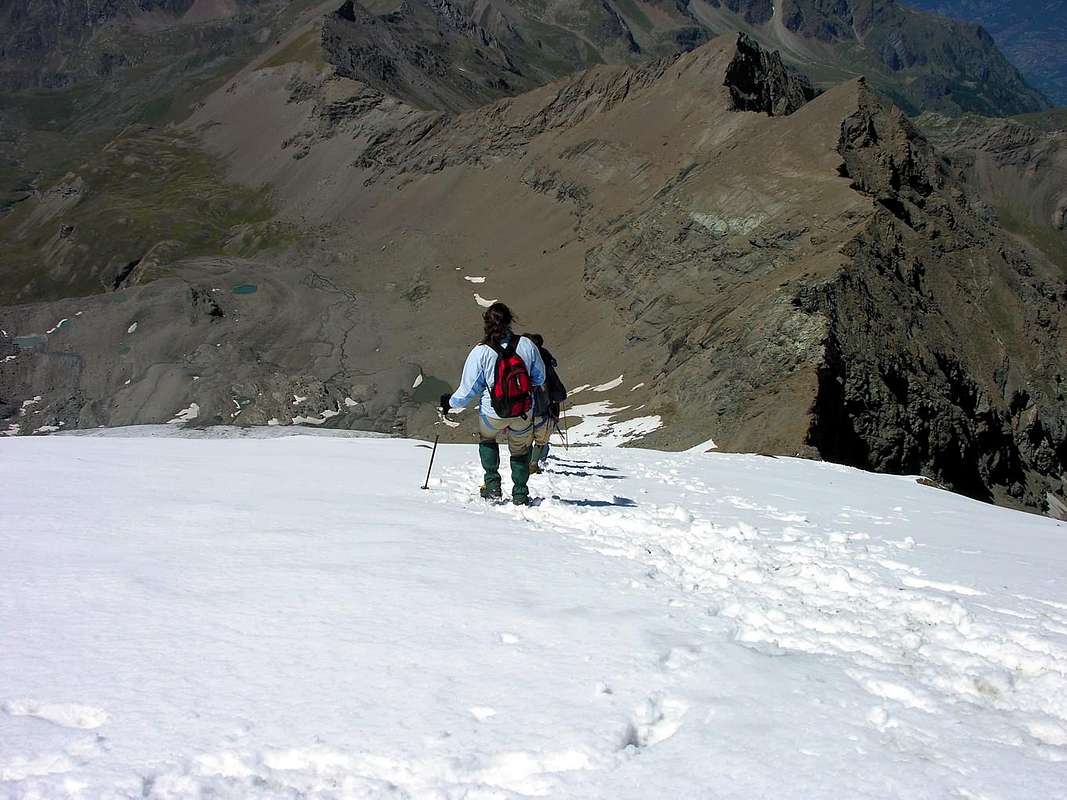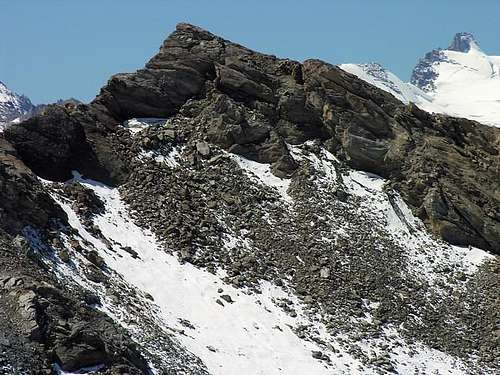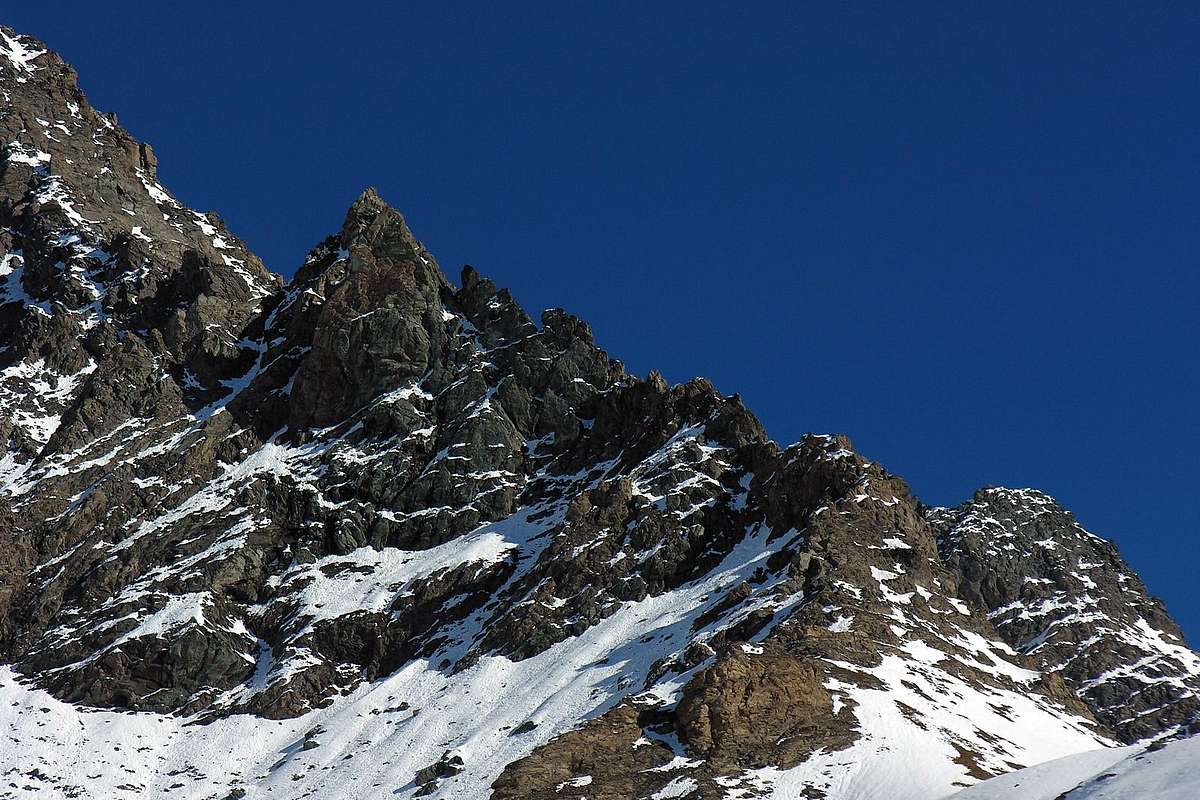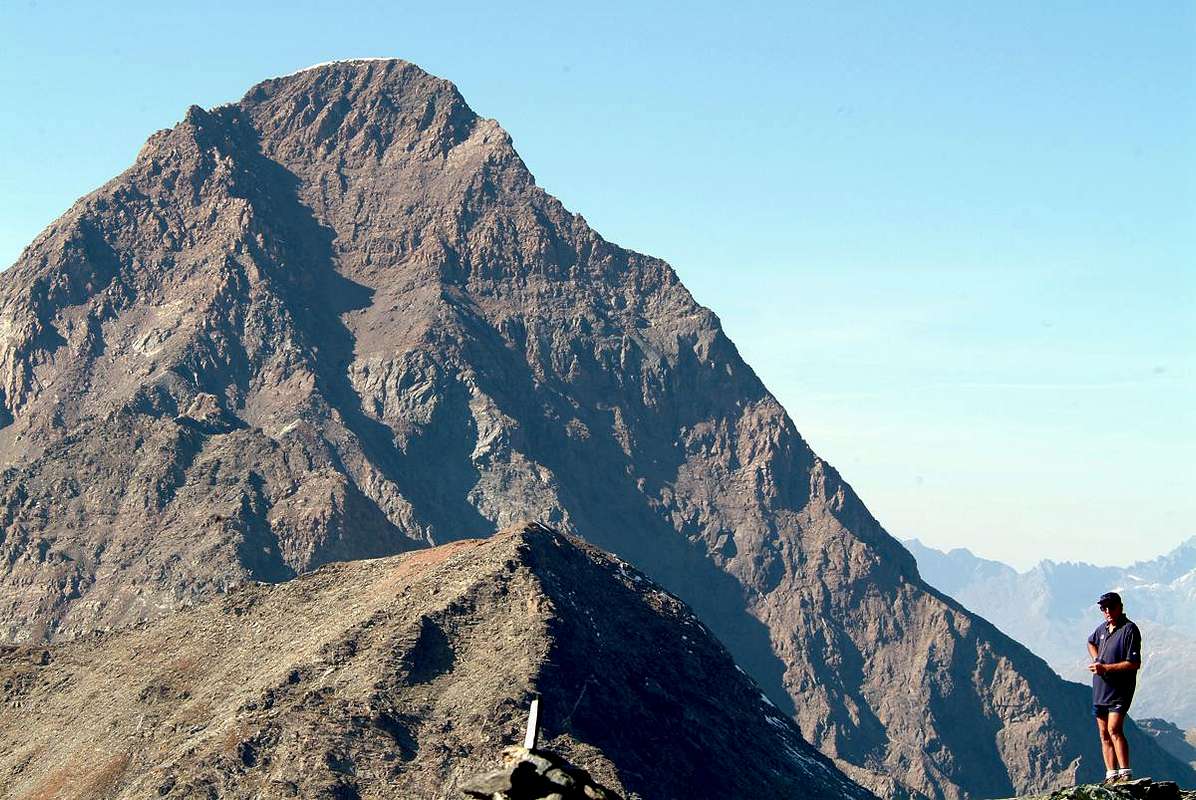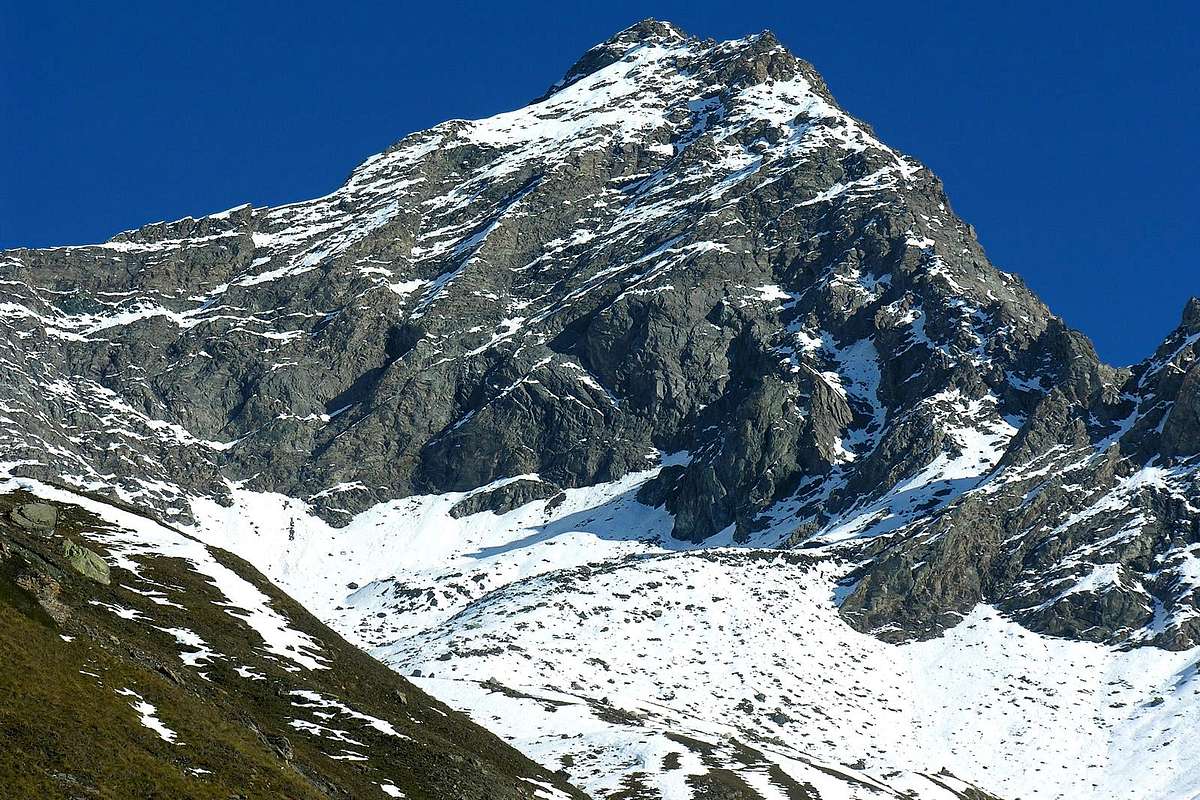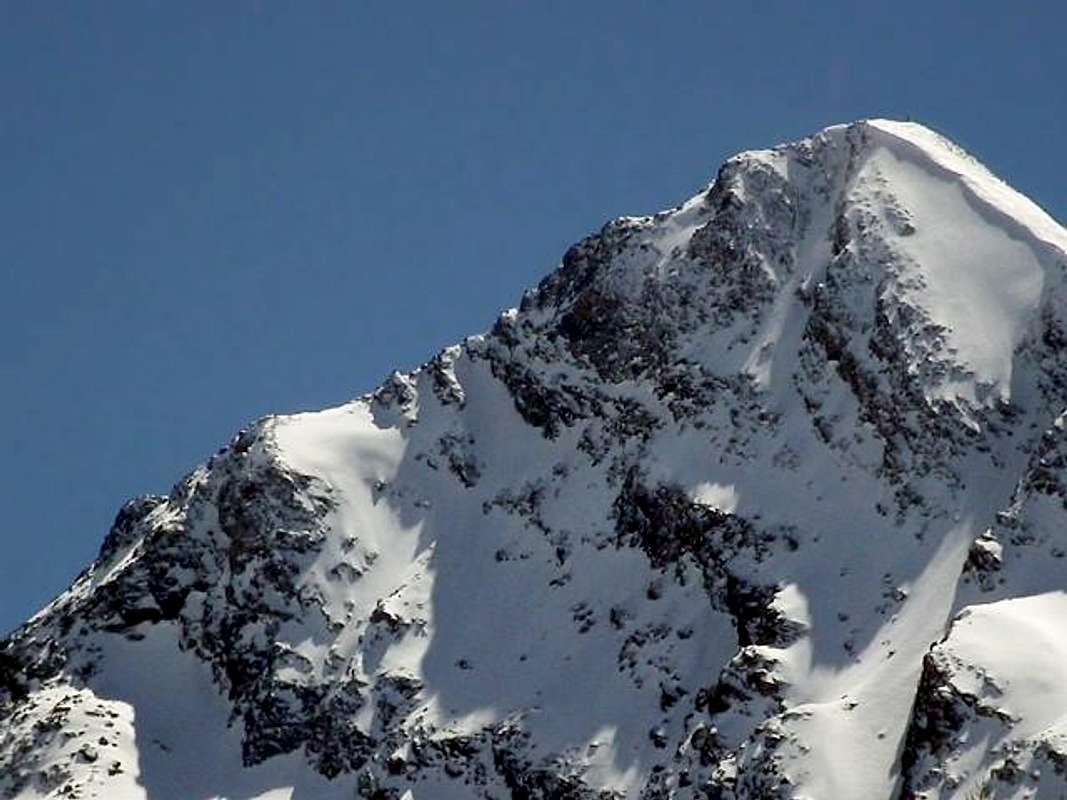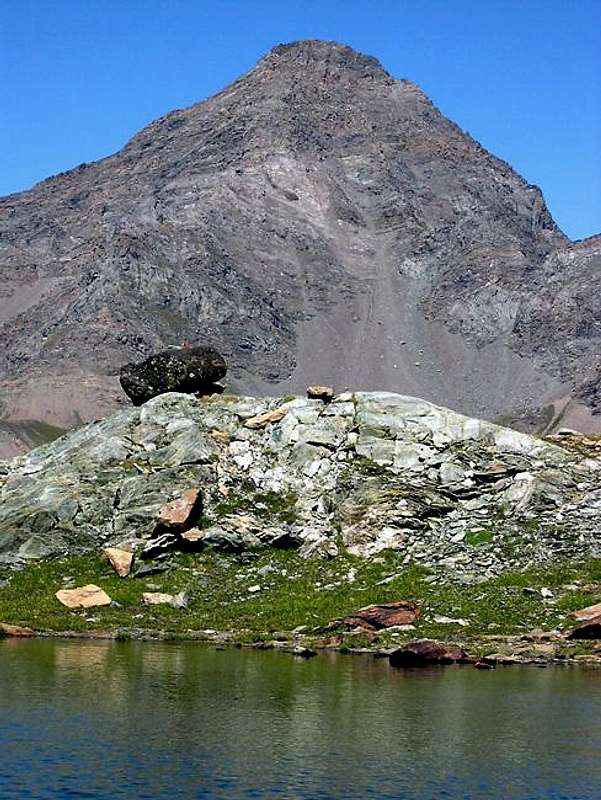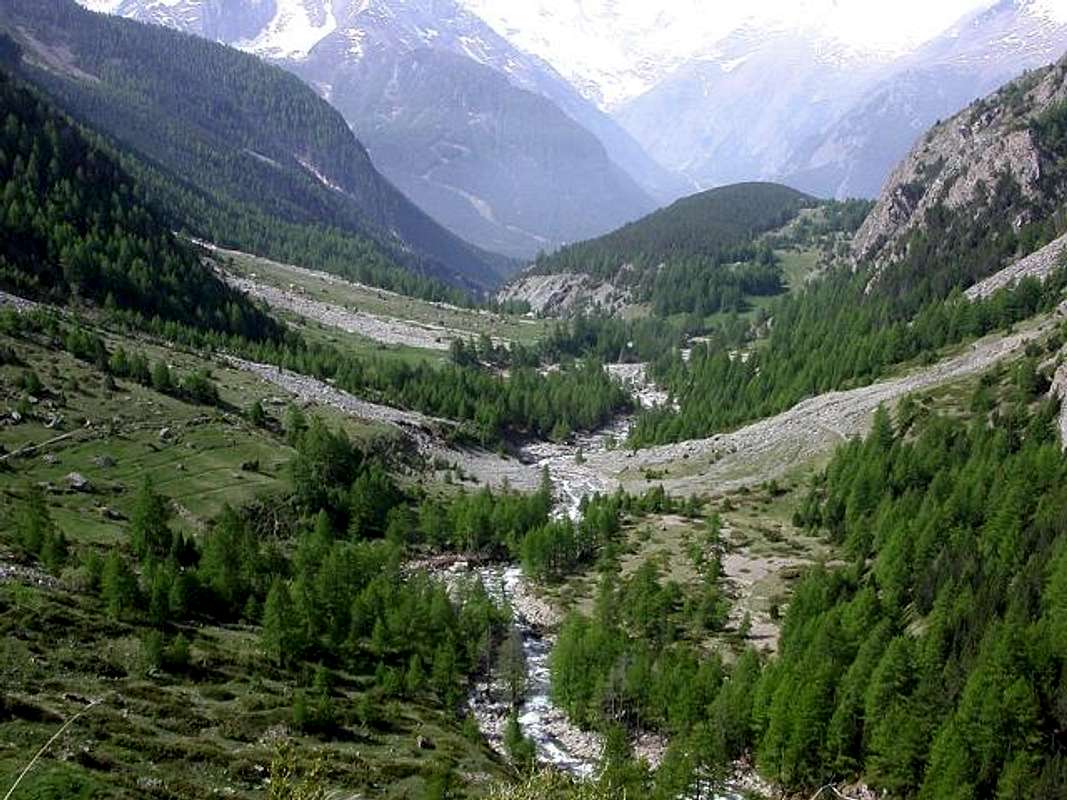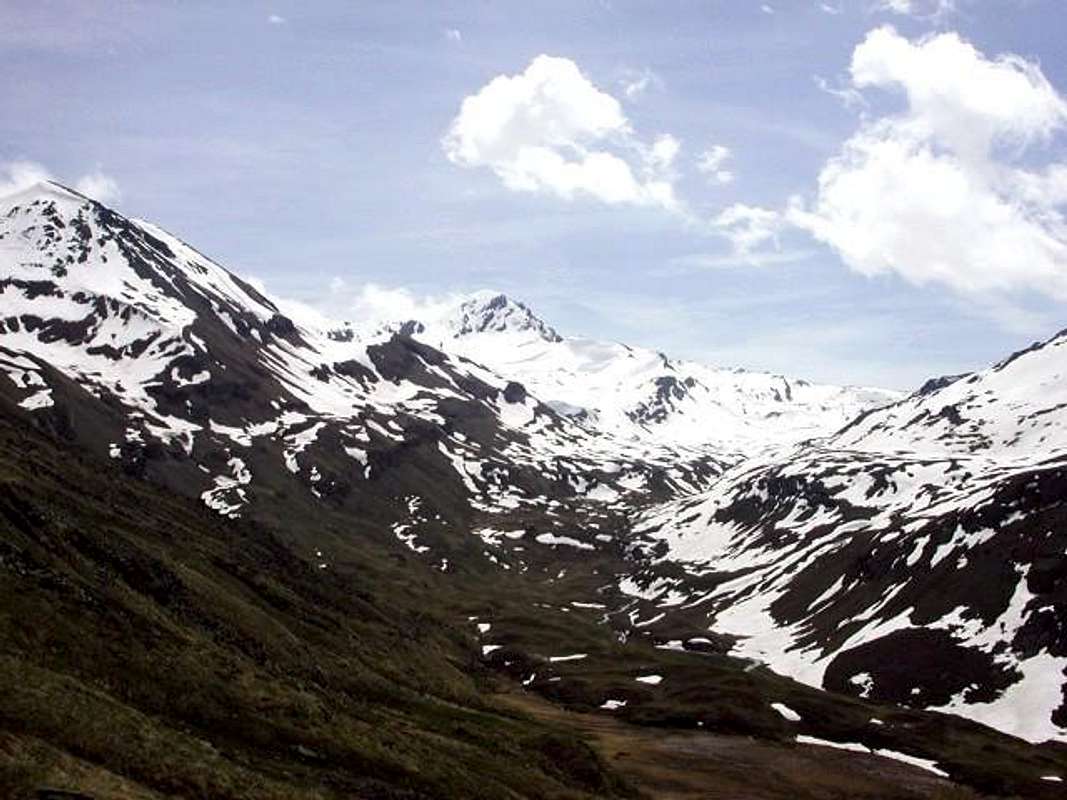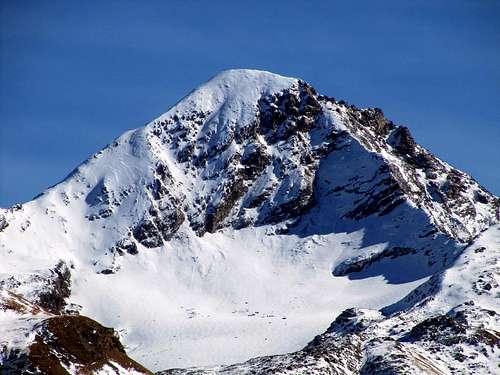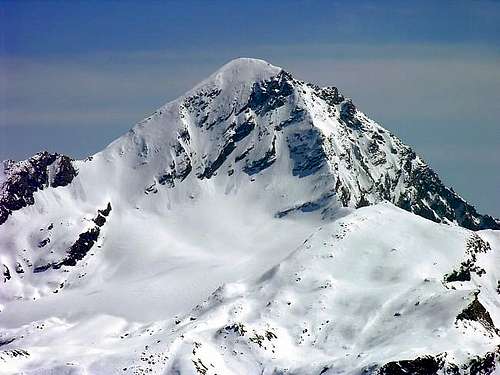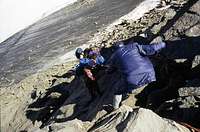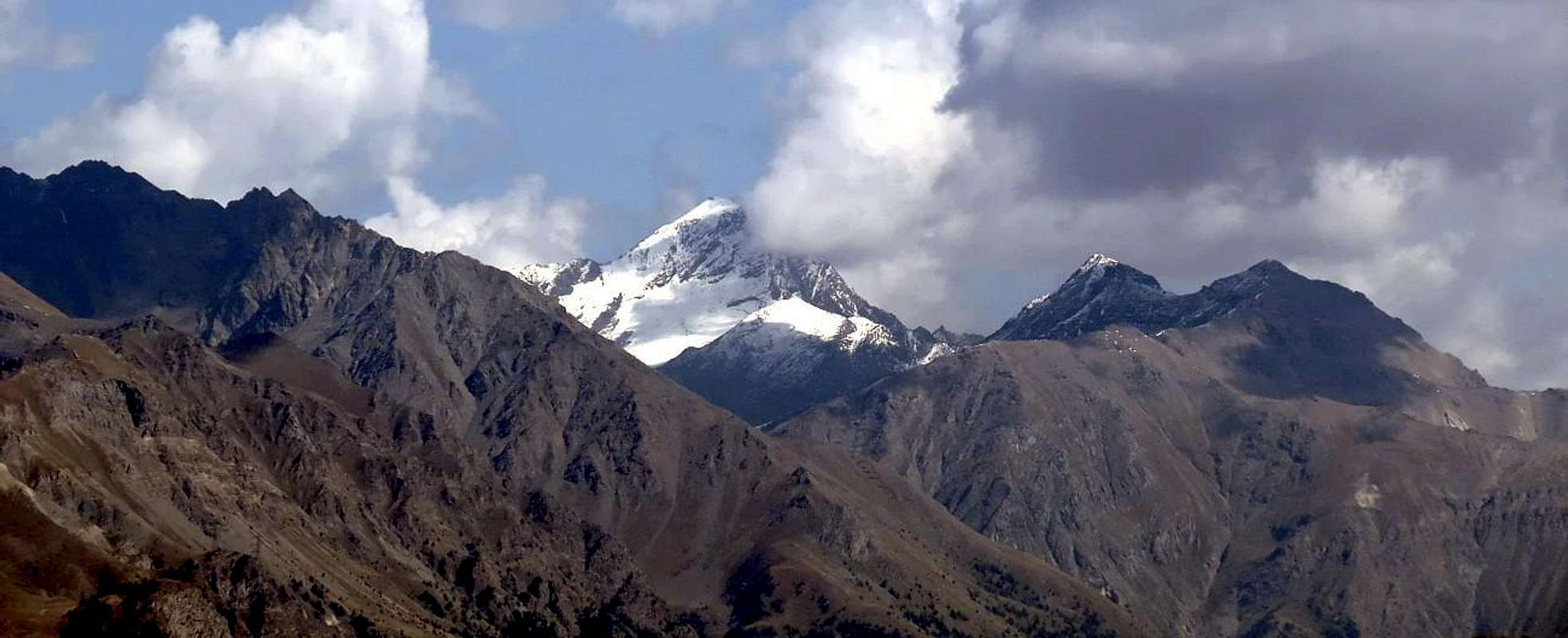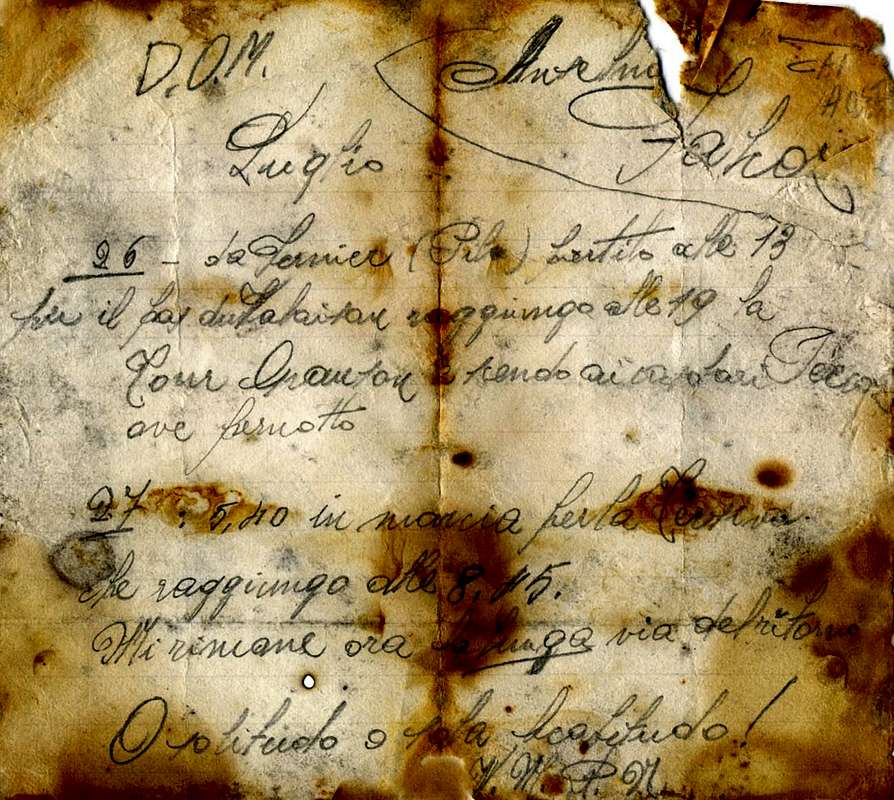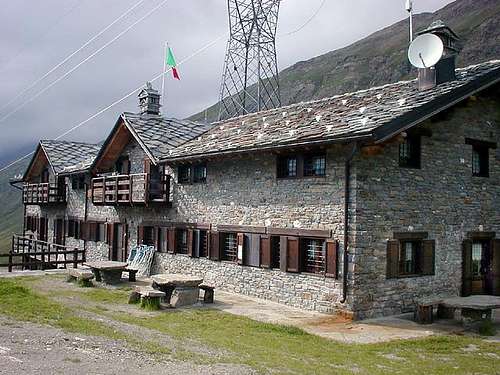-
 55980 Hits
55980 Hits
-
 97.28% Score
97.28% Score
-
 67 Votes
67 Votes
|
|
Mountain/Rock |
|---|---|
|
|
45.62040°N / 7.47585°E |
|
|
Mountaineering |
|
|
11532 ft / 3515 m |
|
|
Overview
 La Punta Tersiva è una montagna piramide-sagomata ed elegante messa fra tre valli: Clavalité (verso Fènis), Urtier e Grauson (verso Cogne). Dalla sua cima è possibile ammirare una delle prospettive a 360° più attraenti dell'intero cerchio alpino, incluse tutte le montagne della Valle d'Aosta, dal Massiccio del Gran Paradiso al Gruppo del Monte Rosa. Alcuni scalatori affermano che dalla sua Vetta la vista spazia con un volo aereo dal Fiume Po (in direzione d'Oriente) insino al Mar Ligure (a Meridione). In primo piano, è di particolar interesse la prospettiva del Gruppo dell'Emilius, così come verso i Valloni della Valeille, del Bardoney e delle Acque Rosse.
Labelled panoramic view from the summit of Tersiva; an unlabelled version can be seen here
The best route to the summit is on the NNW side, along the Tessonet ridge; the other sides have to be avoided because of the poor quality of the rock. The North side is very spectacular; one can catch a glimpse of it going along the main road n°26, between the localities of Champagne and Fénis. Under the North face one can see the small Glacier de la Pointe Tersiva, that late in the summer takes on a greyish colour, because of the frequent fall of detritus from the wall; even if small, nevertheless it becomes spectacular with the first snowfalls, appearing as a tormented glacier crossed by many crevasses. At the foot of the pleasant N-W face there is the Tessonet glacier; the South side is not of any remarkable interest, since it is made up of wrecks and broken big rocks.
Il miglior percorso per la Vetta trovasi sul lato di N-NW, lungo la cresta del Tessonet; gli altri lati sono da evitarsi a causa della cattiva qualità della roccia. Il Versante Settentrionale è molto spettacolare; lo si intravvede lungo la SS.26, tra le località di Champagne e Fénis. Sotto la Faccia Nord si annovera annotandolo il piccolo Glacier de la Pointe Tersiva che in tarda estate assume un color grigiastro, a causa della caduta frequente di detriti dalla parete soprastante; pur se piccolo, ciononostante diviene spettacoloso con le prime nevicate, assumendo le sembranze di un ghiacciaietto tormentato dalla disposizione a pettine dei molti crepacci. Alla base della Parete N-O è da ammirarsi piacevolmente il Ghiacciaio del Tessonet; il lato Meridionale della montagna non è di alcun interesse straordinario, siccome è costituito esclusivamente da dirupi di rocce molto rotte.
|
|||||
Historical and Toponymic Notes
|
Famous from the beginning of the mountaineering the Point Tersiva also known anciently as Punta Doreire (* * * * you see the various small guides by Mario Aldrovandi 1930/32: "Guide of the Valley of Champorcher", "Guide of the Valley of Cogne" afterwards put together and comprehensive besides of "The Valley of the Clavalité" (pages 191/5) in "Guide of the Autonomous Region of the Valley of Aosta" Edit. S.P.E. di Carlo Fanton, Turin, December 31th 1964. In the last one the mountain is treated at page 150 in relation to the Champorcher Valley: "The name Tersiva originates from the transparency of his sky. In Val of Cogne it is also known with the name Doré, (or Dorère) for the golden aspect of which it mantles at the first daylights. I expect that it originates from the coloration of its rocks.", page 195 inherent to the Fénis/Clavalité Valley; and page 289 concerning Cogne Valley or Doré and also Dorère. On the more Western side of the Peak the new Statue of the Virgo (black) has been positioned, after that the white statue, existing up to the end of the years' 90 (in 1997 still in existence; you can see the photo of 1993), he had been object of an intrigue worthy of a thriller. He was found along the walls shattered, because of a lightning bolt, solving the mystery and so definitely putting an end to the diatribe between the mountain climbers of Fénis and those of Cogne. In this way all happily descended and mostly convinced that nobody had cheated.
Famosa fino dall'inizio dell'alpinismo la Punta Tersiva conosciuta anticamente anche come Punta Doreire ( * * * * vedi le varie piccole guide di Mario Aldrovandi 1930/32: Guida della Valle di Champorcher", "Guida della Valle di Cogne" in seguito riunite e comprensiva inoltre de "La Valle della Clavalité" (pagine 191/5) in "Guida della Regione Autonoma della Valle d'Aosta" Edit. S.P.E. di Carlo Fanton Torino 31 Dicembre 1964. In quest'ultima la montagna viene trattata alle pagine 150 a riguardo della Valle di Champorcher : "Il nome Tersiva le é pervenuto dalla limpidezza del suo cielo. In Val di Cogne é conosciuta anche col nome di Punta Doré, (o Dorère) per l'aureo aspetto di cui s'ammanta alle prime luci del giorno. Aspetto che le proviene dalla colorazione delle sue rocce."; 195 inerente alla Valle di Fénis/Clavalité e 289 per quanto concerne la Valle di Cogne.) oppure Doré ed anche Dorère. Sulla Vetta si trova, nel suo lato più Occidentale dove é stata posta, la nuova Statua della Vergine (nera), dopo che quella (bianca), esistente fino al termine degli anni '90 (nel 1997 sussisteva ancora; vedi inoltre foto del 1993), era stata oggetto di un intrigo degno di un romanzo giallo. Venne ritrovata lungo le pareti frantumata, a causa di un fulmine, risolvendo il misterioso problema nonchè ponendo così termine ad una lunga diatriba tra gli alpinisti di Fénis e quelli di Cogne. Così tutti discesero felici e contenti e soprattutto convinti che nessuno avesse barato.
|
Topographical Notes & Paths of Approaches
|
Crests & Ridges
Tersiva constitutes one of the most important peaks of that vast area, immediately South of the Gran Paradiso range, that extends just South of the Dora Baltea river crossing half Valley of Aosta among the Communes of Aymavilles and Pont Saint Martin and besides toward Southeast the whole Valley of Champorcher up to the confinements with the Region Piedmont. In this enormous zone comprehensive beautiful tops as the Emilius Mountain (3.559m), the Chain of the Great Roise (3.356m), the Point Garin (3.451m), the Mont Delà (3.139m), the Mont Glacier (3.186m), the Mount Avic (3.006m) with his Natural Park and on the opposite side over the Torrent Ayasse and to the border with the Valley of the Orco/Ceresole Reale the Rosa of the Banchi (3.164m); among all these ancient pyramids, that seen by Northeast to lower some sun damage a yearning illusion appearing as those of Egypt, the Tersiva it is second in height to the only Emilius Mountain. Nearly positioned to the center of this great area it sends his crests and it falls his walls on the Valleys of Cogne (Wide Valleys of the Urtier and the Grauson) and of Fénis/Clavalité; but his long Ridge South-southeast in direction of the two Towers and the Hill of the Pontonnet goes to also touch the Valley of Champorcher. This mountain results to be a perfect pyramid composed by five crests and as many walls; four of these crests directly climb to the Peak, while the scene or Crest South-southwest goes to join himself with the Crest South-southeast, coming from the Pontonnet Pass (2.897m), as soon as before the Top to quota 2.457m. The other crests, analyzing clockwise the mountain beginning from the Crest North-northwest or by normal, introduces these characteristics:
1) - Crest N-NW: it is the terminal part of the long buttress dividing watershed the Valleys of southwest Cogne and the tall Comba Tersiva in the Valley of East-northeast Fénis/Clavalité; the same one originates from the Tessonet Peak(3.266m) and, after having formed the Quotas 3.188m, 3.213m, 3.273m, 3.280m, 3.305m and 3.327m, known as Coast of the Tessonet, shortly goes down to the Tersiva Pass (3.310/2m) for then to conclude in peak with a linear slope on a trace of path, if he doesn't introduce snowy (generally July and August and, at times, also September and half October). This final line introduces today still an I wait for snowy with snowy frames in beginning of season, but thin to about forty years it was practically ago it for the whole year ( * you see various photos September 1974). Pleasant and elegant ascent rather with the snow, otherwise the crest becomes because of the deposit banal and very attractive in some lines (especially under the Tersiva Pass) and besides annoying.
One can arrive at the Tersiva Pass in three ways: a) - from the Grauson Valley: from the Village of Gimillan or, in local language "patois, Dzimillan to go up again to the Pastures ofE'closeur, Alp Pila and to the Grauson Vieux; to the alternative immediately after this old installation to leave on the left the following fork for the Lake Corona or the four Lakes of Lussert and progress instead on the right toward the Pasture of Pralognan and the following one of Ervi(e)llères. From here (you see in the detail the Routes) to climb toward the Glacier of the Tessonet edging it on the left and, on traces in the side moraine (stonemen and cairns), to reach the base of the Pass which he reaches with a steep line on end moraine. It probably corresponds to the route of the first slope in 1842. Paths: n° 8 from Parking near Gimillan Village to cross Ervillères/Doreire Torrents in quota 2.630/50 meters about and after through free trail. Else and better: then with a small path not numbered, that overcomes a throat beside a rocky promontory. The same finishes an evident trace becoming less and less (various cairns) near an undulated morainic highland in which they ogle burdens little ponds, residual of progressive the withdrawal of the Tessonet Glacier (today around the 2.975/3.000 meters around) and from here with the moraine side right (North) or with the border of the glacier at basic the of the pass. b) - from the Valley of the Urtier through the Alp and the Col des Invergneux, the run of the whole Serra Madù or Madou, come down by this last on the Glacier of the Tessonet and North crossing South of the same one rejoining himself to the preceding itinerary at the base of the hill (speaking of this crossing to see the preceding and following sections "Historical, Toponymic Notes" & "Various Anecdotes"). Paths: n°13/TVC/High Route n° 2 from Parking near Lillaz Village to fork 2357 meters; unnumbered small path towards Broillot Pasture and after through linkiing of paths-dirt "poderale" road n° 13A/10/10D to Invergneux Alp and Hill. c) - from the Valley of Fénis/Clavalité: to reach Grand Alpe Pasture and from this the Glacier de la Pointe Tersiva; finally with slope of the same one on his Oriental Face with steep run and statement to the fall of stones and for this motive, to tell the truth, a little frequented. Connection of Paths: through path-dirt "poderale" road n° 2 from Fénis Barche Fraction to Clavalité Tableland in fork 1.551 meters, between Bioley Damon and Crin Villages nearby the Bayette Wood. Path n° 5 to alternative 2.027 meters and final part through path n° 6 towards Grand-Alp Pasture; after through path n° 7/102 to Lavodilec Loch as far as quota 2.127 meters and free route in terminal part on Tersiva Glacier to pass. 2) - Great Crest E-NE: with the preceding one it rather contains by now the rests of the meeting place Glacier de the Pointe Tersiva with traces of glaciation up to the 2.850/2.900 meters. It goes up again awry immediately some grassy and rocky promontories soprastanti the Pastures of Grand Alp (2.120m), where it has beginning the tall Comba Tersiva; it is almost exclusively a rocky crest that constitutes the Normal Route, or at least surely the more frequented, from the Valley of Fénis, even if from this last it is possible to reach the Hill of the Tersiva and to continue along the Crest N-NW (more binding and delicate in the underlying line to the collar). From the Peak it goes down above the Pastures of Grand-Alp, after to first common line, with three great parallel crests, of which dark that to North, to border left hydrographical of the Glacier de the Pointe Tersiva, constitutes the route of slope. From an analysis from the lower part he introduces more difficulty than is not it; if integrally crossed on the thread it also proposes passages of IV-/IV°(all with possibility of avoidance), as from information of "Battisten" Pieiller, of Fénis Municipality, that has crossed it from the forty to the fifty times and as such the KING of this Great Crest can be considered justly. Analyzing the crest in slope is possible to divide it in four sections (you see great photo in opening of "Overview"): a first turned rocky line mostly to North-northeast that flanks the left edge of the Glacier de la Pointe Tersiva, with more rotten rocks; a second turned steep prominence more to East that brings at times to a small snowy crest (as in this photo) and rectilinear pseudo, that finishes with two rocky asperities. Finally a last great rocky jump-wall that, going to melt herself with the Wall North-northeast on the right and with the others two great parallel ribs toward South, directly hands to the Summit. In reality the two great turned dark ribs to East-southeast they already belong to the Face Southeast and are two great pillars of support of the great same crest. In every case climbed long of over 1.200 meters gradient in the line above the Alp and to consider him "mysticism", if effected from the floorvalley or from the Village of Barche, to the beginning of the dirt road "poderale" of the Clavalité large Valley or, better, Tableland. Connection of Paths: through path-dirt "poderale" road n° 2 from Fénis Barche Fraction to Clavalité Tableland in fork 1.551 meters, between Bioley Damon and Crin Villages nearby the Bayette's Wood. Path n° 5 to alternative 2.027 meters and final part through path n° 6 towards Grand-Alp Pasture; after through path n° 7/102 to Lavodilec Loch as far as quota 2.127 meters and, free, Southern deviation to quota 2.518 meters at base of the ridge.
VARYING: with run a few directly but surely more comfort, to still continue on the same path abandoning it when it begins to climb more steeply; to take a small path not numbered on the left instead (West), that reaches the little one and from the forms exotic Shelter of the Marquis Turati (private and closed). From this, turning to Midday, on traces among the pastures to reach the impending moraine, holding to the right himself of the precedent run, to mostly reach the great crest in an elevated point, near the quota 3.338 meters I.G.M
Subdivision of the approaches with departure from three different valleys, as well as respective paths: d) - Valley of Fénis/Clavalité/Tall Comba Tersiva: as the preceding approach up to Grand-Alp and prosecution with the path n° 6 toward South through the High Comba Tersiva pour the Hill of Fénis (2.857m); from this, crossing her "Chemin du Roi", with the path n° 8 coming from Dondena to the neighbor with the Pontonnet. e) - Valley of Cogne/Walloon of the Urtier: with the preceding Approach itinerary n° 1/b up to the alternative 2.507 meters for the Alpage of Invergneux; therefore to East with the path-dirt road "poderale" n° 10F/TVC for the Ponton Pasture up to the alternative 2.641 meters, near her "Baita of Hunters Orlando", and finally with the path n° 10E for the Lakes of the Pontonnet and homonym Hill. f) - Valley of Champorcher: from the Chief town of Chateau (1.427m) for the Royal Road (excavated and open to the vehicles) for Dondena; from the bridge on the Stream Ayasse with the path n° 7B/7C/Haute Route n° 2 to the Refuge de Dondena (2.193m) and he actually still with the same one to the small bridge that crosses the stream toward North. Finally with the path n° 8/8A/8B/8C; you abandon the deviations of these two last for the Fussy and Moussaillon Hills, to continue with 8A for the Fénis Pass, as well as precedent approach. (VARYING: dark or shortcut to North with to small path not numbered but in evidence, that from the hairpin bend among l "Hotel" and the ruins of the ex Barracks it climbs through the pastures near to small torrent and, overcoming two alps, it always conducts to the road excavated for the Miserin inserting itself to quota 2.250 meters around; and besides with the possibility to reach the superior bridge on the Ayasse departing from that inferior, near a gym of rock and with run on a trace of path also it not numbered that it climbs in parallel to the same one, immediately reaching a wide tableland after the bridge.) 4) - Crest S-SW: crest that begins around to 2.820 meters between the Alps of the Invergneux or des Hevergnes (2.524m) to West and those of the Alpages of Ponton (2.631m) more to East, dividing two small secondary vallons, named Cerise Plains, to the slopes of the South Walls and Southwest about the mountain. Very rarely frequented, even if from the attractive aspect for his numerous towers that make to imagine an attractive scaling (passages of III°+/IV° and even of V°), but the quality of the rock doesn't allow to presage nothing of good person. Paths with the preceding approaches-itineraries n° 1/b and n° 3/e up to the alternative 2.507 meters for the Alpage of Invergneux; therefore to East with the path-dirt road "poderale" n°10F/TVC for the Ponton Pasture up to the alternative 2.641 meters, near her "Baita of Hunters Orlando". From this, or just before, without obliged route into moraine to base of crest. 5) - Ridge W-SW: long crest that begins from the Pas des Invergneux (2.902m) and that it constitutes the Normal Street with departure from Lillaz and through the first part of the Valley of the Urtier up to the alternative 2.360 meters before the Alpage de La Manda (2.374m). It crosses the long crest he dictates The Serra Madù or Madou up to the homonym point (3.220m); from this a brief descent (not always simple if the slant is covered from "verglass") hands on the Glacier of the Tessonet, that is crossed toward Northeast rejoining itself to the Route of the Crest N-NW. Or he continues on the same crest and, after a brief descent to the collar 3.198m and overcome the quota 3.282m, with easy passages but exposed the Peak it is reached after a brief more binding final passage (II°+/III°-). * * * It surely constitutes the current NORMAL ROUTE and the more one frequented, with run however only up to the Serra Madù and crossing toward North of the Glacier of the Tessonet to the Tersiva Hill, abandoning so on the left the conclusive part of the great crest that, revolt to East, a West Crest becomes (clearly once enough of fashion). Approach with relative paths: this is the good Approach to the mountain, thanks to the opening of the Shelter Sogno di Berdzé (2.537m) near the near Alp of Peradzà, underlying to the Fenetre de Champorcher (2.826m; with possibility therefore to also use it arriving from the Valley of Champorcher through the path 7B of the "Chemin du Roi" or with the Haute Route n° 2 coming from the Lake and Refuge of the Miserin 2.579m and 2.588m); so doing himself "it breaks" the ascension in two days, avoiding to effect the long ascent from Lillaz in day and passing from the Alp of Invergneux to reach the homonym pass, at the base of the real ridge. With the precedent Approach n° 3 to reach the alternative 2.360 meters and, leaving on the left (North) the deviation for the Alps of the Invergneux and the Ponton. To always continue instead to East with the path n° 10 reaching first the La Manda Pasture (2.374m) and then along the Torrent of Peradzà the shelter, immediately afterwards a splendid source into a boulder. Same give, actually returning a little back a to the hairpin bend 2.498 meters, to take the path unnumbered of connection that in diagonal toward Northwest it crosses the rocky promontory at the base of the Loch Ponton reaching the impending dirt road "poderale" that follows him for brief line. To continue with the path 10D/TVC, same direction, toward the Footstep of Invergneux. NOTE TOPOGRAFICHE e SENTIERISTICA. Creste e Crestoni La Tersiva costituisce una delle vette più importanti di quella vasta area, subito a Meridione della Catena vera e propria del Gran Paradiso, ed estendentesi subito a Sud del Fiume Dora Baltea percorrendo così mezza Valle d'Aosta tra i Comuni di Aymavilles e di Pont Saint Martin ed inoltre verso Sudest tutta la Valle di Champorcher insino ai confini con la Regione Piemonte. In quest'enorme zona comprensiva belle cime come il Monte Emilius (3.559 m), la Catena della Grande Roise (3.356 m), la Punta Garin (3.451 m), il Mont Delà (3.139 m), il Mont Glacier (3.186 m), il Monte Avic (3.006 m) con il suo Parco Naturale e sul lato opposto, oltre il Torrente Ayasse ed al confine con la Valle dell'Orco/Ceresole Reale, la Rosa dei Banchi (3.164 m); tra tutte queste antiche piramidi, che viste da Nordest al calar del sole danno un'illusione struggente apparendo come quelle dell'Egitto, la Tersiva é seconda in altezza al solo Monte Emilius. Posizionata pressoché al centro di questa grande area invia le sue creste e precipita le sue pareti sulle Valli di Cogne (Valloni dell'Urtier e del Grauson) e di Fénis/Clavalité; ma la sua lunga Cresta Sud-sudest in direzione delle due Torri e del Col Pontonnet va a lambire anche la Valle di Champorcher. Questa montagna risulta essere una perfetta piramide composta da cinque creste ed altrettante pareti; quattro di queste creste salgono direttamente alla Vetta, mentre la quinta o Cresta Sud-sudovest va a congiungersi con la Cresta Sud-sudest, proveniente dal Colle Pontonnet (2.897 m), appena prima della Cima a quota 2.457 m. Le altre creste, analizzando la montagna in senso orario a partire dalla Cresta Nord-nordovest o via normale, presentano queste caratteristiche: 1) - Cresta N-NO: è la parte terminale del lungo contrafforte spartiacque divisorio le Valli di Cogne a Sudovest e l'Alta Comba Tersiva nella Valle di Fénis/Clavalité ad Est-nordest; la stessa proviene dalla Punta del Tessonet (3.266 m) e, dopo aver formato le Quote 3.188 m, 3.213 m, 3.273 m, 3.280 m, 3.305 m e 3.327 m, conosciute come Costa del Tessonet, scende brevemente al Colle della Tersiva (3.310/2 m) per poi concludere in vetta con una salita lineare su di una traccia di sentiero, qualora non si presenti innevata (in genere Luglio ed Agosto ed, a volte, pure Settembre e metà Ottobre). Questo tratto finale presenta ancor oggi un'aspetto innevato con cornici nevose in inizio di stagione, ma fino ad una quarantina di anni orsono lo era praticamente per tutto l'anno (* vedi varie fotografie del Settembre 1974). Ascensione alquanto piacevole ed elegante con la neve, altrimenti la cresta diventa banale e molto meno attraente a causa del detrito in alcuni tratti (specialmente sotto il Colle della Tersiva) ed inoltre fastidioso. Per poterla percorrere si deve raggiungere il Colle della Tersiva con tre possibilità: a) - dal Vallone del Grauson: dal Villaggio di Gimillan o, in patois, Dzimillan risalire agli Alpeggi dell'E'closeur, Alpe Pila ed al Grauson Vieux; al bivio, subito dopo questo vecchio insediamento, lasciare sulla sinistra il successivo per il Lago Corona od i quattro Laghi di Lussert e procedere invece sulla destra verso l'Alpe di Pralognan e la seguente di Ervi(e)llères. Da qui (vedi nel dettaglio le Routes) salire verso il Ghiacciaio del Tessonet contornandolo sulla sinistra e, su tracce nella morena laterale e segnalazioni con ometti in pietra, raggiungere la base del Colle al quale si arriva con un tratto più erto su fine morena. Probabilmente corrisponde alla via della prima salita nel 1842. Sentieri: n° 8 dal Parking presso il Villaggio di Gimillan insino alla congiunzione dei Torrenti Ervillères/Doreire a quota 2.630/50 metri circa e dopo senza percorso obbligato. Oppure e meglio: poi con un sentierino non numerato, che supera una gola a fianco di un promontorio roccioso. Lo stesso termina diventando una traccia sempre meno evidente (ometti e tumuli) nei pressi di un altopiano morenico ondulato dentro al quale occhieggiano alcuni laghetti, residuo del ritiro progressivo del Ghiacciaio del Tessonet (oggi intorno ai 2.975/3.000 metri circa) e da qui con la morena laterale destra (Nord) o con il margine del ghiacciaio alla base del colle. b) - dal Vallone dell'Urtier: tramite l'Alpe ed il Col des Invergneux, il percorso dell'intera Serra Madù o Madou, discesa da quest'ultima sul Ghiacciaio del Tessonet e traversata da Sud a Nord del medesimo ricongiungendosi all'itinerario precedente alla base del colle (a proposito di questa traversata vedere le sezioni precenti e successiva "Historical, Toponymic Notes" & "Various Anecdotes"). Sentieri: n°13/TVC/Haute Route n° 2 dal Parking presso la Frazione di Lillaz insino al bivio 2.357 metri; sentierino non numerato in direzione dell'Alpeggio Broillot e susseguente liaison dei sentieri-strada poderale n°13A/10/10D verso l'Alpe dell'Invergneux ed omonimo Colle. c) - dalla Valle di Fénis/Clavalité: raggiungere Grand-Alp e da questa il Glacier de la Pointe Tersiva; infine con risalita del medesimo sulla sua Faccia Orientale con percorso ripido ed esposto alla caduta di pietre e per questo motivo veramente poco frequentato.
2) - Crestone E-NE: con la precedente racchiude i resti dell'ormai alquanto ridotto Glacier de la Pointe Tersiva con tracce di glaciazione fino ai 2.850/2.900 metri. Risale subito a monte dei promontori erbosi e rocciosi soprastanti l'Alpeggio di Grand Alp (2.120 m), dove ha inizio l'Alta Comba Tersiva; è una cresta quasi esclusivamente rocciosa che costituisce la Via Normale, od almeno sicuramente la più frequentata, dalla Valle di Fénis, anche se da questa ultima è possibile raggiungere il Colle della Tersiva e proseguire lungo la Cresta N-NO (più impegnativo e delicato nel tratto sottostante al colletto). Dalla Vetta discende sopra l’Alpe di Grand-Alp, dopo un primo tratto comune, con tre crestoni paralleli, dei quali quello più a Settentrione, a margine idrografico sinistro del Glacier de la Pointe Tersiva, costituisce la via di salita. Da un'analisi dabbasso si presenta più difficile di quanto non lo sia; se percorsa integralmente sul filo propone passaggi anche di IV°-/IV° (tutti aggirabili), come da informazioni del fénisano "Battisten" Pieiller che l'ha percorsa dalle quaranta alle cinquanta volte e come tale può essere giustamente considerato il RE di questa Grande Cresta. Analizzando la cresta in salita è possibile dividerla in quattro sezioni (vedi foto grande in apertura di "Overview"): un primo tratto di roccia più rotta rivolto maggiormente a Nord-nordest fiancheggiante il bordo sinistro del Glacier de la Pointe Tersiva; un secondo risalto più ripido rivolto più ad Oriente adducente ad una crestina a volte innevata (come in questa foto) e pseudo rettilinea, che termina con due asperità rocciose. Infine un ultimo grande salto a mò di parete rocciosa che, andando a fondersi con la Parete Nord-nordest sulla destra e con le altre due grandi costole parallele verso Sud, porta direttamente alla Sommità. In realtà le due grandi costole rivolte più a Est-sudest fanno già parte della Faccia Sudest e costuiscono due grandi pilastri di sostegno della grande cresta medesima. In ogni caso salita lunga di oltre 1.200 metri circa di dislivello nel tratto sopra l'Alpe e da considerarsi "mistica", se effettuata dal fondovalle ovvero dal Villaggio di Barche, all'inizio della strada poderale della Clavalité. Collegamento dei sentieri: "poderale"-sentiero n° 2 da Fénis Frazione Barche verso l'Altopiano della Clavalité insino al bivio 1.551 metri, tra i Villaggi di Bioley Damon e Crin al limitar del Bois de Bayette. Sentiero n° 5 fino al bivio 2027 metri e parte finale tramite sentiero n°6 attraverso Grand-Alp; infine per mezzo del sentiero n° 7/102 per il Lago di Lavodilec fino a quota 2.127 metri e percorso terminale a Meridione, non obbligatorio, verso la base del crestone alla quota 2.518 metri. VARIANTE: con percorso un pò meno diretto ma sicuramente più comodo, proseguire ancora sullo stesso sentiero abbandonandolo quando inizia salire più ripidamente; prendere invece un sentierucolo non numerato sulla sinistra (Ovest), che raggiunge il piccolo e dalle forme esotiche Rifugio del Marchese Turati (privato e chiuso). Da questo, volgendo a Mezzogiorno, su tracce tra i pascoli raggiungere la soprastante morena, tenendosi più a destra del precedente percorso, e raggiungere il crestone in un punto maggiormente elevato, presso la quota 3.338 metri I.G.M.  3) - Crestone S-SE: prende le sue origini dal Colle Pontonnet (2.827 m, raggiungibile sia dalla Valle di Cogne per il lungo Vallone dell'Urtier con partenza dal Villaggio di Lillaz (1.631 m), sia da quella di Champorcher con percorso analogo partendo da Dondena (2.100 m); la stessa prima forma le due sommità della Tour Pontonnet, divise dal Colletto 3.148 m, poi discesa ad un successivo e più marcato Colletto 3.085 m, risale meno frastagliata, ma con qualche passaggio roccioso interessante, andando a congiungersi con la Cresta SO ad un'ottantina di metri dalla Vetta. Percorso abbastanza frequentato, anche per le segnalazioni con vernice gialla. La stessa cresta, effettuabile con diversi aggiramenti, molto probabilmente non é stata ancora salita sul filo dal Colle Pontonnet alla Vetta, scavalcando le due Torri Pontonnet (3.173/4 m la Punta SE e 3.185 m la NO) ed alcuni tratti successivi; presenta difficoltà da PD a AD e passaggi di II°/II°+/III°-/III° (presso una torre rossiccia a quota 3.330 metri circa, con possibilità di scalarla direttamente per mezzo di un camino roccioso uscendone a sinistra oppure aggirandola ad Ovest) con il percorso segnalato, ma sicuramente superiori e su roccia non troppo buona nel caso di salita integrale. E’possibile inoltre evitare le due torri scendendo ad Ovest nella piccola conca morenica, sottostante la Parete Sud, e risalire sulla cresta tramite pendii morenici, a volte innevati, che portano per mezzo di un canalino incassato ad una forcella a quota 3.150 metri circa subito a Settentrione della frastagliata guglia 3.171 metri (via raramente percorsa perché poco conosciuta e maggiormente esposta alla caduta di pietre; più lunga del percorso tradizionale segnalato ed in ogni caso sconsigliabile). Suddivisione degli avvicinamenti con partenza da tre vallate diverse, nonché sentieri relativi:
d) - Valle di Fénis/Clavalité/Alta Comba Tersiva: come il precedente avvicinamento fino a Grand-Alp e prosecuzione con il sentiero n° 6 verso Sud attraverso l'Alta Comba Tersiva verso il Colle di Fénis (2.857 m); da questo, incrociando le "Chemin du Roi", con il sentiero n° 8A proveniente da Dondena al vicino Col Pontonnet. e) - Valle di Cogne/Vallone dell’Urtier: con il precedente Avvicinamento itinerario n° 1/b fino al bivio 2.507 metri per l'Alpe d'Invergneux; quindi ad Est con il sentiero-"poderale" n°10F/TVC per l'Alpe Ponton fino al bivio 2.641 metri, presso la "Baita dei Cacciatori Orlando", ed infine con il sentiero n° 10E per i Laghi del Pontonnet ed omonimo Colle. f) - Valle di Champorcher: dal Capoluogo di Chateau (1.427 m) per la Strada Reale (sterrata ed aperta ai veicoli) per Dondena; dal ponte sul Torrente Ayasse con il sentiero n°7B/7C/Alta Via n°2 al Refuge de Dondena (2.193 m) ed ancora con la medesima sino al ponticello che attraversa il torrente verso Nord. Infine con il sentiero n° 8/8A/8B/8C; abbandonate le deviazioni di questi due ultimi per i Colli Fussy e Moussaillon, continuare con il n° 8A per il Col Fénis, nonché precedente avvicinamento. (VARIANTI: oppure scorciatoia più a Settentrione con un sentierino non numerato ma ben in evidenza, che dal tornante tra l'Albergo e le rovine dell'ex Caserma sale attraverso i pascoli presso un torrentello e, superando due alpeggi, conduce sempre alla strada sterrata per il Miserin inserendosi a quota 2.250 metri circa; ed inoltre con la possibilità di raggiungere il ponte superiore sull'Ayasse partendo da quello inferiore, presso una palestra di roccia e con percorso su di una traccia di sentiero anch'essa non numerata risalente in parallelo al medesimo, raggiungendo un largo pianoro subito appresso il ponte). 4) - Cresta S-SO: cresta che inizia a 2.820 metri circa tra gli Alpeggi dell'Invergneux o des Hevergnes (2.524 m) ad Occidente e quelli dell'Alpe Ponton (2.631 m) più ad Oriente, dividendo due piccoli valloni secondari, detti Plans de Cerise, alle pendici delle Pareti Sud e SO del monte. Molto raramente frequentata, anche se dall'aspetto attraente per i suoi numerosi torrioni che fanno immaginare una scalata attraente (III°+/IV° con passaggi anche di V°), ma la qualità della roccia non lascia presagire nulla di buono. Sentieri con i precedenti avvicinamenti-itinerari n° 1/b, nonché 3/e, fino al bivio 2.507 metri per l'Alpe dell'Invergneux; quindi ad Est con il sentiero-"poderale" n° 10F/TVC per l'Alpe Ponton fino al bivio 2.641 metri, presso la "Baita dei Cacciatori Orlando", oppure immediatamente prima senza percorso obbligato all'interno della morena.
5) - Crestone O-SO: lunga cresta che prende le mosse dal Pas des Invergneux (2.902 m) e che costituisce la Via Normale con partenza da Lillaz ed attraverso la prima parte del Vallone dell'Urtier insino al bivio 2.360 metri prima dell'Alpe de la Manda (2.374 m). Percorre la lunga cresta detta Serra Madù o Madou fino all'omonima punta (3.220 m); da questa una breve discesa (non sempre semplice se il pendio è ricoperto da "verglass") porta sul Ghiacciaio del Tessonet, che s'attraversa verso Nordest ricongiungendosi alla Via della Cresta N-NO. Oppure si continua sulla stessa cresta e, dopo una breve discesa al colletto 3.198 m e superata la quota 3.282 m, con tratti facili ma esposti si raggiunge la Vetta dopo un breve passaggio finale più impegnativo (II°+/III°-). * * * Costituisce attualmente la VIA NORMALE con percorso però solo fino alla Serra Madù ed attraversamento verso Settentrione del Ghiacciaio del Tessonet in direzione del Colle della Tersiva, abbandonando così sulla sinistra la parte conclusiva della grande cresta che, rivolta ad Est, diventa nettamente una Cresta Ovest (una volta abbastanza di moda). Avvicinamento con relativi sentieri: questo é il miglior Approccio alla montagna, grazie all'apertura del Rifugio Sogno di Berdzé (2.537 m) presso la vicina Alpe di Peradzà, sottostanti alla Fenetre de Champorcher (2826 m; con possibilità quindi di utilizzarlo anche arrivando dalla Valle di Champorcher tramite il sentiero 7B del "Chemin du Roi" o con l'Alta Via n° 2 proveniente dal Lago e Rifugio del Miserin 2.579 m e 2.588 m); così facendo si "spezza" l'ascensione in due giornate, evitando d'effettuare la lunga salita da Lillaz in giornata e passando dall’Alpe d’Invergneux per raggiungere l’omonimo colle, alla base della cresta vera e propria. Con il precedente Avvicinamento n° 3 raggiungere il bivio 2.360 metri e, lasciando sulla sinistra (Nord) la deviazione per le Alpi dell'Invergneux e del Ponton. Proseguire invece sempre ad Est con il sentiero n° 10 raggiungendo prima l'Alpe de La Manda (2.374 m) e poi lungo il Torrente di Peradzà il rifugio, appena dopo una bella sorgente sgorgante da un macigno. Dallo stesso, ritornando un poco all'indietro sino al tornante 2.498 metri, prendere il sentiero di collegamento non numerato, che in diagonale verso Nordovest attraversa i promontorii rocciosi alla base del Lago Ponton raggiungendo la soprastante strada poderale che si segue per breve tratto. Continuare con il sentiero 10D/TVC, stessa direzione, verso il Passo d'Invergneux. 6) - Wall N-NE: it deals with the elegant triangular wall impending the minuscule Glacier of the Tersiva; limited to the right from the Crest N-NW and to the left from the long "Crestone" E-NE, that respectively constitutes the Normal Routes of climbed from the Valley of Cogne (possibility of had climbed since two separate Valleys of the Grauson or the Urtier) and from Fénis/Clavalité Valley; it goes down, broken by three separate rocky bands interrupted from steep snowfields, for over 500 meters around progressively attenuating his inclination against the frontal moraine of the same one. He is ploughed in his center by a long and great sinuous gully, that is undoubled to around 220 meters by the Peak against a rocky band to form of pear tilted toward left; his left branch (East) it goes out on the Great Crest E-NE to few meters of the Top, while that opposite opens upward to form of funnel transforming itself in a white and elegant sheet snowy. Less interesting the side of right of the wall that is dissolved in snowcapped intercalated by small rocky bands thin against the Hill of the Tersiva. Surely in more remote times the same one had to almost entirely have covered from a great snowy slant with inclinations among the 40° and the 50°/55° from which as soon as small scattered rocks appeared on the surface. It is surely the most binding via of the mountain; a little frequented, is returned in top in the last years thanks to the appointment of mountain climber of Fénis, Saint Marcel and Quart three Municipitalities.
Approach: similar to these of itineraries 1 e 2 (Tersiva Pass and Great Ridge E-NE) and basic VARYING immediately afterwards Grand-Alp Pasture (2.120m). 7) - Face SE and Slope E-SE: the great Southern Wall turns toward Southeast above the final part of the Tall Comba (= Basin) Tersiva before the Hill of Fénis you divides into two well separate parts: Face SE and Slope E-SE or Couloir de the "Grande Raye": the imposing Slope E-SE some mountain is undoubled, especially in the most elevated part, distinguishing on the left a less steep slope and formed by deposits with blocks of rock that, through a great rocky channel, it goes up again it from quota 3.060/70 meters around reaching the great Ridge E-SE, after the two Pontonnet's Towers, immediately above quota 3.457m, near a great ledge known by the local mountain climber with the name of the "Grande Raye"; on the right instead a steep wall also it formed by broken and broken rocks directly goes up again with more southeast exposure to the Peak with a terminal part though a wall of 150 meters around, very exposed. The first run is known on the spot as "Voie de the Great Raye", or "Route of the Great Ledge" and it constitutes alternative an to the great and long Ridge E-SE it for the mountain climber of Fénis, from which it is rather frequented; the wall to side instead, as to make as we know, it doesn't result crossed (* * even if in the "Book of Peak of the Tersiva" since 1921 until to the September 1974 an ascension is recorded from four mountaineers "Cognensi" (? or of Champorcher Valley ??) in 1952 but, to our notice it turns to the South Wall; you see more before the "HISTORICAL NOTES") and he should offer, from an analysis from the lower part or frontal from the Tower Ponton or from the Mont Moutsaillon, scrambled an enough difficult and surely dangerous for the quality of the rock and the suspended material. (*** To the necessity and always in SP, to go to see in "ALL ROUTES (20 + 1 historical) OF PUNTA TERSIVA") to the itineraries n° 6 and n° 6bis enclosing a photo with their tracks of the routes).
Approach: equal to these of itineraries 1, 6 and 2 (Tersiva Pass, North-northeast Wall and Great Ridge E-NE) and basic VARYING, immediately afterwards Grand-Alp Pasture. From Alp (2.120m), over and side by side with the Clavalité Torrent, through the path n° 6 towards Tall Tersiva's Basin up to the resort also called the "Grand Ra(e)ye" and final approach to Western on moraine with not forced route. 8) - Face S: the hold Face South, that doesn't exist for anybody other preceding publication almost it didn't exist, it is not a ghost given birth by a fervent imagination, on the contrary it really subsists and it is inclusive among the great Ridge E-SE that from the Peak it goes down to the Hill Pontonnet and the Crest S-SW that from the quota 3.457m or Antesummit Southern to the conjunction with the preceding one, go down actually to the quota 2.820m forming a series of showy pinnacles and steeples. Of triangular form and hold, it was almost compressed from the two crests above you quotas, salt above a minuscule walloon of which out goes out some rivulets inside the moraine of basic impending the path n° 10E for the Lakes Pontonnet in direction of the homonym pass. The same, departing from it "The Hunters Cabin Orlando" (2.641m) with direction North, goes up again at first a steep rump for then to turn around brusquely around 2.760/70 meters to straight angle in direction of the footstep. Above this passage, after a brief grassy slant with deposits, the small foretold vallone raises him; this goes up again more and more from the quota 2.808 meters through a steep moraine toward the base of the wall to quota 3.000 meters around breaking itself against the rocky clog of the same one. From this point the wall raises him, ploughed in its mean by an a little also accented channel it rocky, for over 450 meters to finish to the quota 3.457m; constituted by broken rocks and also minced surely doesn't introduce attractions for the climb with notable objective dangers for the fall of stones. And it is for this motive that ascensions of the same one don't be recorded, unless in 1952 the four mountaineers of Cogne or of Champorcher (?) have not climbed her in first ascension, as from us supposed. The transcript on the "Book of the Tersiva 1921/1974" from the same ones he speaks however of Wall S-E. Don't wait him for a profitable climb, as already says, for the bad quality of the rock; to avoid in every case after recent snowfall or with the wall covered not by well transformed snow. In fact from a personal analysis, transiting under the same one with such conditions, the he is noticed to fall of numerous small snowslides. Approach: equal to these of itineraries 3/e and 4 (South-southeast Ridge and South-southwest Crest) and deviation to Northern from the path n° 10E to quota 2.808 meters at the beginning of basal moraine, with free route on the same up to the base of face. 9) - Wall S-W: wider and also steep, but shorter even if of few, the Wall SW salt from the moraines impending the so said Plan de Cerise from the moraine to quota 3.100 meters around directly to the Peak. Understood in a vast and imposing amphitheater formed by the Crest S-SW on his right and from the long Ridge W-SW said of the Serra Madù, that reaches, climbing over some small quotas, the Pas des Inverneux (2902m). You raises therefore for 415 meters around, uniform in separate two sectors from to great rocky central channel, to go out and directly and easily reaching the Peak in dark his Western side, nearby the new Statue of the Virgo. Probably slope an only turned by the rope of September 1898 with itinerary i don't notice, but almost surely supporting himself on the sides of the aforesaid couloir; its slope appears from an analysis from the lower part it more difficulty than is not it indeed as it shows the time employed by the first mountaineers (2h'15). It also results certainly exposed, as in effects all the routes on the walls of this ancient mountain, to the falls of stones.
Approach: the same of itineraries n° 5 and n° 4 (W-SW Ridge and in parallel S-SW Crest and following deviation to Northern from the path n° 10D/TVC to quota 2.849 meters at the beginning of basal moraine, with "free" trail on the same up to the base of the face in quota 3154 metres. Or identical to these of itineraries 3/e and 4 (Great Ridge S-SE and parallel S-SW Crest and following deviation in Northwest from the path n° 10E near the "Baita dei Cacciatori Orlando", through a small path of connection not numbered to the path 10D/TVC in quota of 2.650/700 meters about, and as far as the beginning of basal moraine. In the photo of Emilius the Wall Southwest from Urtier hanging valley: on the right the Crest South-southwest, to left or in Western the West-southwest Ridge. 10) - Wall N-NW: it deals with the last of the walls, also from the chronological point of view of the slopes being dated September 1988 in the analysis clockwise effected. You raises above the most Oriental borders of the Glacier of the Tessonet, also known as Glacier Doreire, ancient name of the Point Tersiva (550 meters around in width and almost 800 meters in length, as from the last surveys); from quota 3.220 meters around it climbs to the Peak with a gradient of 300 meters around dominating, to form of stumpy and strong pyramid, the same one. Its structure is formed from a flared channel and sinuous that divides it in two well separate parts: that of left or Northern it is formed from a rocky rib that accompanies climbing in its sketch the great central couloir, descending gradually then less steep and very interesting with deposits and broken rocks I pour the Pass of the Tersiva; more attractive the right or Southern part, formed by a wide and steep wall supported by three rocky-ribs/pillars basal up to around its half, where the same go to melt themselves in an only wall of rotten rocks, very dangerous for the discharges of stones. The slope bringing itself to the attack with the overcoming of a series of crevasses from the right toward the left was effected for then grabbing the first rib/pillar of left of the aforesaid three. The same one was gone up again on its near side of left but out of the great central gully; overcome a series of small rocky strips horizontal pseudo the same one, it concluded him supporting in the last 70/80 meters in the same couloir with which to go out of the wall, where the two Crests West-southwest and South-southwest they gather him above the Wall Southwest, and with a terminal line of not great inclination finally and directly reach the Peak to the feet of the Madonna. Climbed more dangerous than difficult, it asks for conditions of well transformed snow and absence of "verglass" on the rocks, factor that is rather rarely verified. To avoid to the right absolutely the sector through the others two small pillars and overhanging wall, subject to continuous discharges also of boulders, as it is deduced by the material deposited to his base on the Tessonet Glacier. Approach: like for the itineraries 1/a from Grauson's large Valley to N-NW Crest and brief crossing to East-southeast of the glacier, also 1/b from Urtier Valley towards the same through the Serra Madù and traverse of Tessonet Glacier in North-northeast direction. Versanti, Facce e Pareti
6) - Parete N-NE: trattasi dell'elegante parete triangolare soprastante il piccolo Ghiacciaio della Tersiva; limitata a destra dalla Cresta N-NO ed a sinistra dal lungo Crestone E-NE, che costituiscono rispettivamente le Vie Normali di salita dalla Valle di Cogne (possibilità di salita dai due distinti Valloni del Grauson o dell'Urtier) nonché del lungo Vallone di Fénis/Clavalité; scende, spezzata da tre distinte fasce rocciose interrotte da ripidi nevai, per oltre circa 500 metri attenuando progressivamente la sua pendenza contro la morena frontale del medesimo. E' solcata nel suo centro da un lungo canalone sinuoso, sdoppiantesi a circa 220 metri dalla Vetta contro una fascia rocciosa a forma di pera inclinata verso sinistra; il suo ramo sinistro (Est) esce sul Crestone E-NE a pochi metri dalla Cima, mentre l'opposto apresi verso l'alto a forma d'imbuto tramutandosi in un bianco ed elegante lenzuolo innevato. Meno interessante il settore di destra della parete, che si stempera in nevati intercalati da fascette rocciose fino contro il Colle della Tersiva. Sicuramente in tempi più remoti la stessa doveva essere ricoperta quasi per l'intero da un grande pendio nevoso con pendenze tra i 40° ed i 50°/55° dal quale appena affioravano roccette sparse. Risulta sicuramente la via più impegnativa della montagna; poco frequentata, è ritornata in auge negli ultimi anni grazie all'impegno di alpinisti dei tre Comuni di Fénis, Saint Marcel e Quart.
Avvicinamento: identico a quelli degli itinerari 1 e 2 (Colle della Tersiva e Crestone E-NE) e VARIANTE di base subito dopo Grand-Alp (2.120 m). In the photo from Northern View: on the left the tall part of Great Ridge E-NE, frontally the midst-high of the N-NE Wall and in right the final of N-NW Crest or Standard Route. 7) - Faccia SE nonché Versante E-SE: la grande Parete Meridionale rivolta verso Sudest sopra la parte finale dell'Alta Comba Tersiva prima del Colle di Fénis si divide in due parti ben distinte: Faccia SE e Versante E-SE o "Couloir de la Grande Raye": l'imponente Versante E-SE della montagna si sdoppia, soprattutto nella parte più elevata, distinguendo sulla sinistra un versante meno ripido e formato da detriti con blocchi di roccia che, tramite un canalone roccioso, lo risale da quota 3.060/70 metri circa raggiungendo il Crestone E-SE, dopo le due Tours Pontonnet, subito sopra la quota 3.457 m, presso un cengione conosciuto dagli alpinisti locali con il nome della "Grande Raye"; sulla destra invece una parete più ripida, anch'essa formata da rocce rotte e spezzate, risale con esposizione più a Sudest direttamente alla Vetta con una parte terminale formata da una muraglia di 150 metri circa, piuttosto esposta. Il primo percorso è conosciuto in loco come "Voie de la Grande Raye", ovvero "Via della Grande Cengia" e costituisce un'alternativa al lungo Crestone E-NE per gli alpinisti di Fénis, dai quali è piuttosto frequentato; la parete a lato invece, per quanto è dato a sapersi, non risulta percorsa ( ** anche se nel "Libro di Vetta della Tersiva" dal 1921 insino al Settembre1974 viene registrata un'ascensione da parte di quattro "Cognensi" (? o di Champorcher ??) nel 1952 ma, a nostro avviso rivolta alla Parete Sud; vedi più avanti le "NOTE STORICHE") e dovrebbe offrire, da un'analisi dabbasso o frontalmente dalla Torre Ponton o dal Mont Moutsaillon, un'arrampicata abbastanza difficile e sicuramente pericolosa per la qualità della roccia, nonché per il materiale sospeso. ( *** All'uopo e sempre in SP, andare a vedere in "ALL ROUTES (20 + 1 historical) OF PUNTA TERSIVA") agli itinerari n° 6 e n° 6bis con allegata una foto con i relativi tracciati). Avvicinamento: similmente a quelli degli itinerari 1, 6 e 2 (Colle della Tersiva, Parete N-NE e Gran Cresta E-NE) nonché VARIANTE di base, immediatamente appresso Grand-Alp. Dall'Alpeggio (2.120 m), subito sopra e parallelamente al Torrente Clavalité, tramite sentiero n° 6 attraverso l'Alta Comba Tersiva ed insino alla località detta "Grand Ra(e)ye" con avvicinamento finale ad Occidente sulla morena e percorso non obbligato. 8) - Faccia S: la stretta Faccia Sud, che non é insita in nessuna altra precedente pubblicazione quasi non esistesse, non é un fantasma partorito da una fervida fantasia, bensì sussiste realmente ed é compresa tra la grande Cresta E-SE che dalla Vetta scende al Colle Pontonnet e la Cresta S-SO che dalla quota 3.457 m, o Antecima Meridionale alla congiunzione con la precedente, scende sino alla quota 2.820 m formando una serie di vistosi pinnacoli e guglie. Di forma triangolare e stretta, quasi fosse compressa dalle due creste sopra citate, sale al di sopra di un minuscolo vallone dal quale fuori escono alcuni rigagnoli all'interno della morena di base soprastante il sentiero n° 10E per i Laghi Pontonnet in direzione dell'omonimo colle. Lo stesso, partendo dalla "Baita dei Cacciatori Orlando" (2.641 m) con direzione Nord, risale dapprima una ripida groppa per poi svoltare bruscamente sui 2.760/70 metri circa ad angolo retto in direzione del passo. Sopra questo passaggio, dopo un breve pendio erboso con detriti, si innalza il piccolo vallone predetto; questo risale dalla quota 2.808 m tramite una morena sempre più ripida verso la base della parete a quota 3.000 metri circa infrangendosi contro lo zoccolo roccioso della medesima. Da questo punto la muraglia si innalza, solcata nel suo mezzo da un poco accentuato canale anche esso roccioso, per oltre 450 metri per terminare alla quota 3.457 m; costituita da rocce rotte ed anche trite, sicuramente non presenta attrattive per l'arrampicata con invece notevoli pericoli oggettivi per la caduta di pietre. Ed é per questo motivo che non si registrano ascensioni della stessa, a meno che nel 1952 i quattro alpinisti di Cogne o di Champorcher (?) non l'abbiano salita in prima ascensione, come da noi supposto. La trascrizione sul "Libro della Tersiva 1921/1974" da parte dei medesimi parla però di Parete S-E. Non aspettarsi una arrampicata remunerativa, come già detto, per la cattiva qualità della roccia; da evitare in ogni caso dopo recente nevicata o con la parete ricoperta da neve non ben trasformata. Infatti da un'analisi personale, transitando sotto la medesima con siffatte condizioni, si é notato il cadere di numerose piccole slavine.
Avvicinamento: uguale a quelli degli itinerari 3/e, nonché 4 (Crestone S-SE e parallela Cresta S-SO) e successiva deviazione a Settentrione dal sentiero n° 10E verso la quota 2.808 metri all'inizio della morena basale, con percorso "libero" della medesima insino alla base della faccia. 9) - Parete SO: più larga ed anche più ripida, ma più breve anche se di poco, la Parete SO sale dalle morene soprastanti il così detto Plan de Cerise dalla morena a quota 3100 metri circa direttamente alla Vetta. Compresa in un più vasto ed imponente anfiteatro formato dalla Cresta S-SO sulla sua destra e dalla lunga Cresta O-SO detta della Serra Madù, che raggiunge, scavalcando alcune piccole quote, il Pas des Inverneux (2.902 m). Si eleva quindi per 415 metri circa, divisa in due distinti settori da un canalone centrale roccioso, raggiungendo direttamente la Vetta nel suo lato più Occidentale, dove é stata posita la nuova Statua della Vergine. Probabilmente salita un'unica volta dalla cordata del Settembre 1898 con itinerario non noto, ma quasi sicuramente appoggiandosi sui lati del canale suddetto; la sua salita appare da un'analisi dabbasso più difficile di quanto non lo sia effettivamente come dimostra il tempo impiegato dai primi salitori (2h'15). Certamente anch'essa risulta esposta, come d'altronde tutte le vie sulle pareti di questa antica montagna, alle cadute di pietre.
Avvicinamento: uguale a quelli degli itinerari n° 5 e n° 4 (Crestone O-SO e parallela Cresta S-SO e successiva deviazione a Settentrione dal sentiero n° 10D/TVC verso la quota 2.849 metri all'inizio della morena basale, con percorso "libero" della medesima insino alla base della faccia a quota 3.154 metri. Oppure uguale a quelli degli itinerari 3/e e 4 (Crestone S-SE e parallela Cresta S-SO e successiva deviazione a Nordovest dal sentiero n° 10E presso la "Baita dei Cacciatori Orlando", con un sentierucolo di raccordo non numerato verso il sentiero 10D/TVC alla quota di 2.650/700 metri circa e fin all'inizio della morena basale. 10) - Parete N-O: trattasi dell'ultima delle pareti, pure dal punto di vista cronologico delle salite essendo datata Settembre del 1988, nell'analisi in senso orario effettuatasi. Si eleva sopra i margini più Orientali del Ghiacciaio del Tessonet, conosciuto pure come Ghiacciaio Doreire, antico nome della Punta Tersiva (550 metri circa in larghezza e quasi 800 metri in lunghezza, come dagli ultimi rilevamenti); da quota 3.220 metri circa sale alla Vetta con un dislivello di 300 metri circa dominando, a forma di piramide tozza e robusta, il medesimo. La sua struttura é formata da un canalone svasato e sinuoso che la divide in due parti ben distinte: quella di sinistra o Settentrionale é formata da una costola rocciosa affiancante salendo nel suo disegno il grande canale centrale, digradando poi meno ripida e molto meno interessante con detriti e sfasciumi verso il Colle della Tersiva; più attraente la parte destra o Meridionale, formata da una larga e ripida parete sorretta da tre costole/pilastro basali fino a circa la sua metà, dove le stesse vanno a fondersi in un'unica muraglia di rocce rotte, alquanto pericolose per le scariche di sassi. La salita venne effettuata portandosi all'attacco con il superamento di una serie di crepacce dalla destra verso la sinistra per indi afferrare la prima costola/pilastro di sinistra delle tre suddette. La medesima fu risalita sul suo lato di sinistra vicino ma fuori dal grande canale centrale; superata una serie di piccole strisce rocciose pseudo orizzontali, la salita si concluse appoggiando negli ultimi 70/80 metri nel canale stesso con il quale uscire fuori dalla parete, dove le due Creste O-SO e S-SO si riuniscono al di sopra della Parete SO, e con un tratto finale di non grande pendenza infine raggiungere direttamente la Vetta ai piedi della Madonna. Ascensione più pericolosa che difficile, richiede condizioni di neve ben trasformata ed assenza di "verglass" sulle rocce, fattore verificantesi piuttosto di rado. Da evitare assolutamente il settore più a destra tramite gli altri due piccoli pilastri e soprastante parete, soggetta a scariche continue anche di macigni, come si evince dal materiale depositato alla sua base sul Ghiacciaio del Tessonet.
Avvicinamento: come per gli itinerari 1/a dal Vallone del Grauson per la Cresta N-NO e breve traversata ad Est-sudest del ghiacciaio, nonché 1/b dal Vallone dell'Urtier alla stessa tramite la Serra Madù e l'attraversamento del Ghiacciaio del Tessonet verso Nord-nordest. |
Getting there
BY CAR:
|
BY PLANE:
- Aeroporto "Corrado Gex" Saint Christophe (Aosta).
First Ascents
- Firs Ascent W Arête: P. B. Chamonin (Curate of Cogne) with a student, (Aug 23th, 1842).
- First ascent winter: Giuseppe Corona and others, (Feb 17th, 1875).
- S-E Arête: G. P. Carrel, J. A. Garth Marshall, P. Giacosa and E. Jantet, (Jul 1872).
- N-NW Arête: D. W. Freshfield and F. Dévouassoud, (Aug 1877).
- S-SW Arête: F. Santi and G. Cavagnot, (Aug 1895).
- S-W Wall: L. and R. Marchetti and L. Jantet, (Sep 01th, 1898).
- E Arête: E. Bravo, B. Garelli, C. Giachino, O. Nay, G.Pollano A. Maquignaz and others, (Jun 24th, 1901).
- N-NE Wall: Giovan Battista Bozzino and Arnaldo Bertucci, (Aug 21th, 1910).
- N-NE Wall Direct Route: Gigi Panei and Lucien Salval, (Sep 05th, 1937).
- Face S or Wall SE?: I. Minet, E. Gontier, N. Gontier and D. Glarey, (Jul 27th, 1952).
- N-W Wall: Osvaldo Cardellina, lone, (Sep 10th, 1988).
Routes
| ROUTE TO PUNTA TERSIVA FROM GIMILLAN
Difference in height: about 1.800 meters.
Ascent time: 7-8 hours.
Descent: along the ascent route.
Equipment: duvet, rope, crampons and ice-axe.
Go right starting from the car park of Gimillan: after few meters the indications for Lussert Lakes, St. Marcel Pass, etc. are found. The pathway is indicated by the yellow circle 9A and by yellow strips marked on stones along the route. The path begins going immediately uphill, then the slope decreases as we go beyond a little chapel dedicated to the Virgin (1.836m). Soon the path resumes to go up and splits in two, before it begins to penetrate into the Grauson Valley: it's possible to continue following the right one that goes down as far as the Ecloseur small Bridge (1.904m), but in such a case we must go up again; it's better to follow the left one that, in practice without losing height, arrives at the bridge under the Alpeggio Pila (2.025m), cross it and, following the stepped pathway, overcome the rocky bastion with a fine waterfall aside.
|
|
At this point the path turns right markedly entering, high on the torrent, into a small valley; by an alternation of steep and slight slopes, it reaches a panoramic cross, on the edge of a pleasant plateau (superb view of the far Grivola!). The path goes through the meadows, slightly descendind: after the Alpi di Grauson Vecchie (2.271m), cross the torrent on the Pikaciù Bridge and begin again to go up, reaching the wide upper part of the Grauson Valley. For the first time the Tersiva put it in appearance, while, looking into the distance, the end of the valley appears, close by the Passo d'Invergneux (2.905m) and the Serra Madù, WSW ridge of the Tersiva. Shortly afterwards one meets the signs indicating the ways on the left to Laures Pass (3.035m) and St. Marcel Pass (2.916m). On the contrary go straight ahead along the pathway n° 4, few meters later you can see on the right the Alpeggio Pralognan (2.418m). Continue as far as the ruins of the Alpeggio Ervillières (2.519m), then make your way towards the foot of the Tessonet glacier, ascend it as far as the steep rocky pass at the height of 3.312m. Go on the wide and rather easy NNW ridge, often snow-covered, leading to the final summit (3.515m), where you find a trigonometric signal and a statue of the Virgin. The route from Gimillan, as well as very long, in practice is lacking in any support point, since the Bivouac Tentori (12 places), got in a wing of the Alpeggio Grauson Nuovo (2.540m), burned into flames in the year 2001.
|
|
SALITA ALLA PUNTA TERSIVA da GIMILLAN
Differenza in dislivello: approssimativamente 1.800 metri.
Tempo di salita: 7-8 ore.
Discesa: lungo il medesimo percorso di ascesa.
Attrezzatura: giacca a vento-duvet, corda, ramponi e piccozza.
Iniziare dal posteggio di Gimillan: dopo pochi metri si incontrano le indicazioni per Laghi di Lussert, riscontrando la via Colle di Saint Marcel, ecc. Il sentiero è indicato dal cerchio 9A giallo e da strisce dello stesso colore marcate su pietre lungo l'itinerario di salita. Il percorso incomincia immediatamente in salita, poi il pendio decresce appena oltrepassata una cappelletta dedicata alla Madonna (1.836 m). Presto il sentiero si sdoppia, prima che incominci a penetrare nella Valle del Grauson: è possibile continuare seguendo il ramo "diritto" che s'allunga, dopo una discesina, al Ponte de l'Ecloseur (1.904 m); ma in tale caso poi devesi nuovamente risalire. E’ meglio seguire quello di sinistra che, in pratica senza quasi perdere in dislivello, arriva al ponte appena sotto l'Alpeggio Pila (2.025 m); lo si sorpassi e lo si sopravvanzi seguendo lo stesso sentiero. Poi superarlo di lato vincendo un bastione roccioso, con bella cascata in vista. A questo punto il percorso gira a destra entrando marcatamente, alto sul torrente, in una valletta; con un'alternanza di pendii dolci a più ripidi, raggiunge una croce panoramica, sull'orlo di un piacevole altopiano (superba vista della lontana Grivola!). Il percorso supera i prati, scendendo leggermente: dopo le Alpi di Grauson Vecchie (2.271 m), attraversare il torrente sul Ponte di Pikaciù e ricominciare a salire, giungendo nella parte superiore e più larga e spaziosa del Vallone di Grauson. Per la prima volta si mette in mostra la Tersiva, mentre, guardando in distanza, si scorge la fine della valle, dischiusa ad Ovest-sudovest dal Passo d'Invergneux (2.905 m) e dalla Serra Madù, sulle quali si eleva la Tersiva con l'omologa cresta. In breve si incontrano le segnalazioni indicanti sulla sinistra la via per il Col Colle di Laures (3.035 m) ed all'opposto per quello di Saint Marcel (2.916 m). Si vada avanti diritto lungo il sentiero indicato con il n° 4, subito osservando sulla destra l'Alpeggio di Pralognan (2.418 m). Continuare verso le rovine dell'Alpeggio Ervillières (2.519 m), intravvisibili in lontananza; poi indirizzarsi verso il piede del Ghiacciaio di Tessonet. Risalire verso il lontano e ripido passo all'altezza di 3.312 m. Seguire la larga e piuttosto facile Cresta Nord-nordovest, spesso ricoperta da neve, che conduce alla cima (3.515 m), ove trovasi un tripode trigonometrico ed una statua della Vergine. L'itinerario da Gimillan, oltre ad esser molto lungo, in pratica è privo di alcun punto di appoggio, fino al Bivacco Tentori (12 posti letto), ottenuto presso un'ala dell'Alpeggio Grauson Nuove (2.540 m), che purtroppo andò distrutto dal fuoco nell'anno 2001.
|
ROUTE TO PUNTA TERSIVA FROM LILLAZ
Winter Tersiva
Various Anecdotes
VARIOUS ANEDOCTES - 1): WHEN A CIGARETTE SAVES YOUR LIFE
ANEDDOTI VARI - 2): E DICEAN CHE DALLA TERSIVA POTEASI VEDER IL MAR
Dicevan che dalla Punta Tersiva si può vedere il Mare. Il Mar Ligure, guardando in grande lontananza al Sudest (vedi Mario Aldrovandi in "Guida della Regione Autonoma della Valle d'Aosta" 1930/2 e 1964, in pagina 289: "Dalla Tersiva, nelle giornate limpide, si può vedere il mare." Altri, come Giovanni Bobba e Luigi Vaccarone in "Guida delle Alpi Occidentali – Vol. II. Graie e Pennine PARTE SECONDA Le Valli di Aosta, di Biella, della Sesia e dell'Ossola", Edit. Sezione del C.A.I. di Torino del 25 maggio 1896, pagine 65/6, vi osservavan nuove meraviglie: "Il panorama che si scorge da questa elegante e svelta piramide, che sorge ben isolata da ogni lato, é uno dei più rinomati della Valle d'Aosta; esso rivaleggia con quello del Monte Emilius, superiore forse quest'ultimo come veduta sulla cerchia delle Pennine, inferiore certamente se si consideri che non soltanto le Alpi si scorgono dalla Tersiva, ma anche larga parte della pianura padana, solcata da fiumi scintillanti. Ne acquista una maggior varietà, largo compenso a chiunque compie l'ascensione.". Ed inoltre Giulio Berutto (+) e Lino Fornelli nella celeberrima Collana C.A.I./T.C.I. Guida dei Monti d'Italia "Emilius Rosa dei Banchi Parco del M. Avic", Edit. Marzo 2005, alla pagina 156: "Famoso il suo panorama che comprende un pò tutte le vette valdostane e ampie zone delle Alpi Occidentali." Più prudente invece il giudizio di Pietro Giglio autore insieme a Nemo Canetta, Andrea Parodi, Lorenzo Barbié e Piero Carlesi in "Le Guide di Alp Grandi Monti/1 Piemonte Valle d'Aosta Lombardia", Vivalda Editori SPA Anno III numero 1 Estate 1989, ove a pagina 87 in "La Montagna di Luce Punta Tersiva da Gimillan", riporta che par che qualche alpinista, in giornate limpide, l'abbia visto ad occhio nudo. Ma l'affermazione risulta alquanto ipotetica e non vengono citate fonti certe, neppure bibliografiche. E comunque il suo parere rimane alquanto dubitativo in tal merito. Ma nelle varie ascensioni personali non ho mai scorto né il mar, né i scintillanti ed argentei fiumi e neppure la grande Piana del Po. Un pò per il cattivo tempo riscontrato; altre volte per la fretta ed altr'ancora perché non ho proprio visto siffatte meraviglie. Neanche dalla Torre di Lavina (3.308 m), dalla Grande Arolla (3.248 m), dal Gran San Pietro (3.692 m) o dalla Roccia Viva (3.650 m), posizionate più vicino a Sudest e Sudovest. Nulla anche dalla Somma Sommità del Granpa (4.061 m), Vetta Massima della Catena alla quale dà il nome e di tutte le Alpi Graie, logicamente Catena del Monte Bianco esclusa. Ma allora non é vero! Oppure il Mar Ligure e la Piana Padana non esistono o son scomparsi, come Atlantide? Ultima ipotesi ch'io sia, se non cieco, sicuramente un pochettin'orbo. Ma allora questa vista del Mare Ligure dalla Sommità della Punta della Tersiva é come l'ARABA FENICE del Metastasio: "Tutti dicon che vi sia, ove sia nessuno lo sa" ??? ... Ma il 5 di Gennaio del 1975 il busillis é definitivamente sciolto grazie ad un parzial uso e non del tutto ortodosso utilizzo della proprietà transitiva dell'uguaglianza: dalla Vetta dell'Emilius, di una scarsa cinquantina di metri più elevato ma allineato sulla medesima direttiva di visuale, in una giornata fredda e di cielo tersissimo, sulla destra a Sudest appare IL MARE con le sue tenue sfumature che galleggiano tra una finissima nebbiolina, mentre in senso opposto verso Occidente la Parete Sud della Tofana di Rozes si staglia, di mezzo profilo, giallognola ed inconfondibile a più di 700 Kilometri tra le Dolomiti!! E siamo in quattro testimoni a vedere!!!.
VARIOUS ANEDOCTES - 3): ENORMOUS & TITANIC ENTERPRISES OR THE TERSIVA FROM VERY GREAT DISTANCES The sporting performances found above him at least three physical abilities of base: the Resistance, the Strength and the Speed with various integrations and correlations among the same ones; in reality they don't exist, since for road you will never meet it Mrs. Resistance, the Girl Speed and not even the Mr. Strength. I am an artificial classification to frame better a typology of sporting discipline, but in the same one these conditional abilities (because they condition the performance) they come to also intend simultaneously themselves if with different percentages; that's why for instance the 100 plain meters are considered the test for excellence of the pure speed, or the lifting weighs (weight lifting) that of the strength and the marathon as the queen of the resistance. But in each of it they are implicit also the others two and to be resistant needs to also have a certain muscular strength and at the same time to proceed with a certain speed. This brief preamble with the purpose to be able to talk of the slopes to the Point Tersiva from great distances, for what we know, quoting three to be able to make its correct conceives of The forces it employee and without to consider the factor time postponing it same to the superficial differentiation between morning and evening or from day to day. For the occasion you are considered an ascension of the Thirties from the Doctor "Ansel" Falcoz and two "personal" of the Seventies finish the one with a success and the other with a failure.c) - from the "Alpine Diaries 1964-2012", of Osvaldo Cardellina in dates June 29th 1973: as usual with "Crevassino" he goes to the total adventure without preset destination or at least with an conceives of initial run that comes then, generally casually, always and rather modified; for the what thing they as out from there great soups and, as in this houses, of the beautiful omelets. You departs, for going to effect the Fires of Peter and Paul on the Peak of the Emilius (3.559m), even among the Village of Tall Les Druges (1.594m) and the Alp Pouria (1.586m) in the Valley of Saint Marcel. Gone up again of the Reserve Marquis Turati to the Houses of Hunting of Mulac-Saint Louis (1.937m) and of Grande Chaux (2.370m); gone up again to the Hill Corona or of Saint Marcel (2.918m). Here to the "Crevassino" a detour comes to mind toward the Tersiva: along the crest watershed we salt to the two Points of Laval (3.091m and 3.101m), to the following Point Gianni Vert (3148m); then, looking above the Pass of Tessonet (3.062m), the homonym Point and Coastline and the distant Tersiva, have an afterthought. He returns back, because to the "Crevassino" the exposed ridges and sharp they don't like really. But unhealthy idea doesn't finish here: bypass of the Mont Vallonet (3.098m) and descent to the homonym Hill (3.062m), climbed to the Point of Leppe (3.305m), come down on its snowy Slope Northwest to a small saddle 3.181 meters and slope to the Quota 3.221 meters or Point of Lussert, further come down by the steep Wall South of broken rocks of this last reaching the Inferior Lake of Lussert (2.721m). You starts over climbing toward the Middle Lake (2.800m) and then that Superior (2.907m); therefore he goes to the Col des Laures (3.036m) passing therefore in the third vallon of the day. Crossing at the base of the East Wall of the Red Point, on a fatiguing and boring moraine of great reddish and sharp blocks, and gone up again to the Hill of Arbolle (3.154m) and entry in the quarter or Vallon of Arbolle. Revolving the Point of Three Western Capuchins we reach the homonym pass. Here the débacle happens: at first it stops him the "Crevassino", that has ended the gasoline, then "burst" me (I have beaten at night with the typewriter up to the three my thesis of degree for the I.S.E.F. and we have departed at five o'clock) and as soon as more aloft on the Crest S-SE, with the dark that catches him discouraging him, it also arrests him the "Peppino". For this year the fires them we can forget. Who wants too much nothing it tightens (Italian proverb)! ... But the adventure is not ended still. The epilogue of this long done race by true camels? To the complete dark we go down to camp out on the Southern bank of the Frozen Lake (2.957m), where we find shelter under a small rocky plate; throwing us above the only cover in our possession (we have neither duvet nor least of all sack to hair) we allow us to have been winding for the cold and starry night. The shivers increase with to spend some times. But in too exaggerated way. To the awakening to the dawn we don't find the anymore "Crevassino": slipped in low of about ten meters, sleeps & snores candidly blissfully wound by it "his" covered. Ah! Go to trust the Friends!!! Finally the long, weary and endless descent to the Fraction of Plan Felina (659m; near the City of Aosta) through the Walloons of Arbolle, Comboé and of the Dard, where the "our" it is object of an endless series of deserved insults. And the recovery of the car to Tall Les Druges? Mystery of the mysteries of "Crevassino"!!!.
ANEDDOTI VARI - 3): IMPRESE TITANICHE E STRATOSFERICHE, OVVERO LA TERSIVA DA GRANDISSIME DISTANZE
Le prestazioni sportive si basano su almeno tre capacità fisiche di base: la Resistenza, la Forza e la Velocità con varie integrazioni e correlazioni tra le medesime; in realtà non esistono, poiché per strada non incontrerete mai la Signora Resistenza, la Signorina Velocità e neppure il Signor Forza. Sono una classificazione artificiale atta ad inquadrare meglio una tipologia di disciplina sportiva, ma nella stessa queste capacità condizionali (perché condizionano la prestazione) vengono a proporsi simultaneamente pur se con percentuali diverse; ecco perchè ad esempio i 100 metri piani sono considerati la prova per eccellenza della velocità pura, oppure il sollevamento pesi (pesistica) quello della forza e la maratona come la regina della resistenza. Ma in ognuna di essa sono implicite anche le altre due e per essere resistenti bisogna avere anche una certa forza muscolare ed allo stesso tempo procedere con una certa velocità. Questo breve preambolo al fine di poter parlare delle salite alla Punta Tersiva da grandi distanze, per ciò che noi conosciamo, citandone tre per poter render la giusta idea dello sforzo impiegato e senza tener dacconto il fattore tempo rimandando lo stesso alla differenziazione semplicistica tra mattino e sera o da giorno a giorno. Per l'occasione vengono prese in considerazione un'ascensione degli Anni Trenta da parte del Dottor "Ansel" Falcoz e due "personali" degli Anni Settanta terminate l'una con un successo e l'altra con un fallimento.
1) - Nobel prize for the Peace, since from now in before him he cannot quarrel among the three Communes anymore, in fact Cogne, Fénis and Champorcher will have each her "proper" POINTE TERSIVA;
2) - Nobel prize for the Geology and Tectonics, because, perhaps, first living human beings to have strengthened a new WORLD OROGENY,
3) - special recognition from the NATIONAL GEOGRAPHIC for the exceptionality of the event, immediately to spread in DVD in the whole TERRESTRIAL GLOBE. In this way the POINTE TERSIVA has Immortalized Anthony & Osw!!!...
ANEDDOTI VARI - 4): UNA NUOVA OROGENESI ! INCREDIBILE E' NATA UNA NUOVA TERSIVA GIUST'AFFIANCO ALLA PRECEDENTE !! ANZI NE SONO NATE ALTRE DUE !!! Abbiamo effettuato una scoperta eccezionale: in Val d’Aosta a cavallo tra i comuni di Cogne, Fénis e Champorcher si é verificata una nuova ed imprevista OROGENESI! Non ci crederete e sicuramente penserete che siamo diventati matti? E no signori: "Carta cantat". Basta infatti comperare la Carta "Les Sentiers de Champorcher" dell'Agosto 2001, 3° Edizione aggiornata e corretta - scala 1:25.000, Cartografia del Comune di Champorcher con realizzazione cartografica e progetto editoriale dell'Hapax di Aosta per accorgersi di questa scoperta eccezionale. Accanto alla "vecchia" Tersiva (qui di 3.512 metri, anziché 3.515), collocata a circa 50°53 ad Ovest e circa 3°80 verso Settentrione, una nuova OROGENESI ha partorito subito a Nord-nordovest e poco oltre il Colle della Tersiva (qui segnalato con = in rosso e con la quota di 3.309 metri ma senza definizione toponomastica) una seconda Tersiva eppiù importante, perché mentre quella tradizionale riportava i caratteri in corsivo questa "new" é riportata addirittura in neretto, ma senza quota. Ma (udite, udite!) sempre sulla stessa direttiva e sulla cresta divisoria spartiacque tra le Valli di Cogne e di Fénis, leggermente più verso N-NO una terza Tersiva appare segnalata con un bel colore blù carta da zucchero o blu nave, anch'essa senza quota. Probabilmente questa improvvisa e doppia OROGENESI ha talmente sorpreso i cartografi, che non hanno fatto in tempo ad effettuare le relative misurazioni. Così abbiamo scoperto che l'antica Costa del Tessonet (varie quote di 3.327 m, 3305 m, 3.280 m, 3.273 m, 3.213 m e 3.188 m) in direzione prima N-NO e poi N-O verso la Pointe du Tessonet (3.266 m) si é improvvisamente e senza alcun preavviso rialzata formando due altre Pointe Tersiva, così brillanti & scintillanti al punto che nessuno riesce a vederle. Daltronde non é la Tersiva la MONTAGNA di LUCE? Per questa incredibile scoperta che Antonio ed io abbiamo celato al Mondo per oltre undici anni.
RITENIAMO GIUSTO
1) - Premio Nobel per la Pace, poiché da ora in avanti non si potrà più litigare tra i tre Comuni, infatti Cogne, Fénis e Champorcher avranno ognuno la "propria" POINTE TERSIVA;
2) - Premio Nobel per la Geologia e Tettonica, perché, forse, primi esseri umani viventi ad aver assodato una nuova OROGENESI PLANETARIA,
3) - Speciale riconoscimento da parte del NATIONAL GEOGRAPHIC per l'eccezionalità dell'evento, da diffondere subito in DVD in tutto il GLOBO TERRESTRE. In questo modo la POINTE TERSIVA ha IMMORTALATO Antonio & Osw !!!...
Gear
Mountaineering equipment, including rope, ice axe, and crampons.When to Climb
|
CLIMBING: during the summer months, taking into account the condition of the snow.
SKI MOUNTAINEERING: April - June The route from Gimillan is recommended for ski mountaineering, paying attention in particular to the part of path between the rocky rampart above the Alpe Pila and the cross before the Alpi di Grauson Vecchie since avalanches can fall from both slopes into the narrow valley, in the case of heavy snow-falls and sudden changes of temperature. |
Mountain conditions
PAY ATTENTION!It is highly recommended to contact the Società delle Guide di Cogne for further information
Huts
- Rifugio Sogno di Berdzé (2.526m)
Bus lines
SAVDA bus lines connect Aosta to Cogne. In addition, both in summer and in winter, SAVDA shuttle bus connect Cogne with the villages (Gimillan and Lillaz, in our case).Red tape
Campings
In all the Aosta Valley the camping is allowed only above 2.500 meters.Meteo
- Meteo: you can find all the needed informations at the official site of the Valle d'Aosta Region:
- Valle d'Aosta Meteo
Webcam
- WEBCAM on Aosta Valley:
- Webcam
Books and Map
BOOKS:
|
- Kompass "Gran Paradiso Valle d'Aosta" Sentieri e Rifugi-Carta Turistica 1:50.000.
- I.G.C. Istituto Geografico Centrale "Gran Paradiso-la Grivola" Carta Turistica 1:25.000.
- I.G.C. Istituto Geografico Centrale "Il Parco Nazionale del Gran Paradiso" Carta 1:50.000.
- Hapax Luglio 2000 "Les Sentiers" Comunità Montana Monte Emilius 1:25.000.
- L'Escursionista "Valle di Cogne Carta dei Sentieri" (n° 10) 1:25.000.
- L'Escursionista "Tour de la Vallée de Cogne Grand Paradis" Carta dei sentieri 1:25.000.
- Hapax "Les Sentiers de Champorcher", Agosto 2001 1:25.000.
- Enrico Editore Ivrea-Aosta "Gruppo del Gran Paradiso" 1:50.000.
Important Information
- REGIONE AUTONOMA VALLE D'AOSTA the official site.
- FONDAZIONE MONTAGNA SICURA Villa Cameron, località Villard de la Palud n° 1 Courmayeur (AO) Tel: 39 0165 897602 - Fax: 39 0165 897647.
- SOCIETA' GUIDE ALPINE DI COGNE Tel. 347/9473526 – 328/1373728.
- A.I.NE.VA. (Associazione Interregionale Neve e Valanghe).
- A.IA.T. Cogne Gran Paradis via Bourgeois n° 34 Tel. 0165-74040. E-mail: aiat@cogne.org
- Ezio Sport articoli sportivi - via Bourgeois n° 64 Tel. 0165-74204.
Useful numbers
- Soccorso Alpino Cogne (SAR) Tel. 3482685406.
- Protezione Civile Valdostana località Aeroporto n° 7/A Saint Christophe (Ao) Tel. 0165-238222.
- Bollettino Meteo (weather info) Tel. 0165-44113.
- Unità Operativa di Soccorso Sanitario Tel. 118.









